Ariadne abandoned by theseus Stock Photos and Images
(62)See ariadne abandoned by theseus stock video clipsQuick filters:
Ariadne abandoned by theseus Stock Photos and Images
 Angelica Kauffmann - Ariadne Abandoned by Theseus - Stock Photohttps://www.alamy.com/image-license-details/?v=1https://www.alamy.com/stock-photo-angelica-kauffmann-ariadne-abandoned-by-theseus-105026863.html
Angelica Kauffmann - Ariadne Abandoned by Theseus - Stock Photohttps://www.alamy.com/image-license-details/?v=1https://www.alamy.com/stock-photo-angelica-kauffmann-ariadne-abandoned-by-theseus-105026863.htmlRMG2TARB–Angelica Kauffmann - Ariadne Abandoned by Theseus -
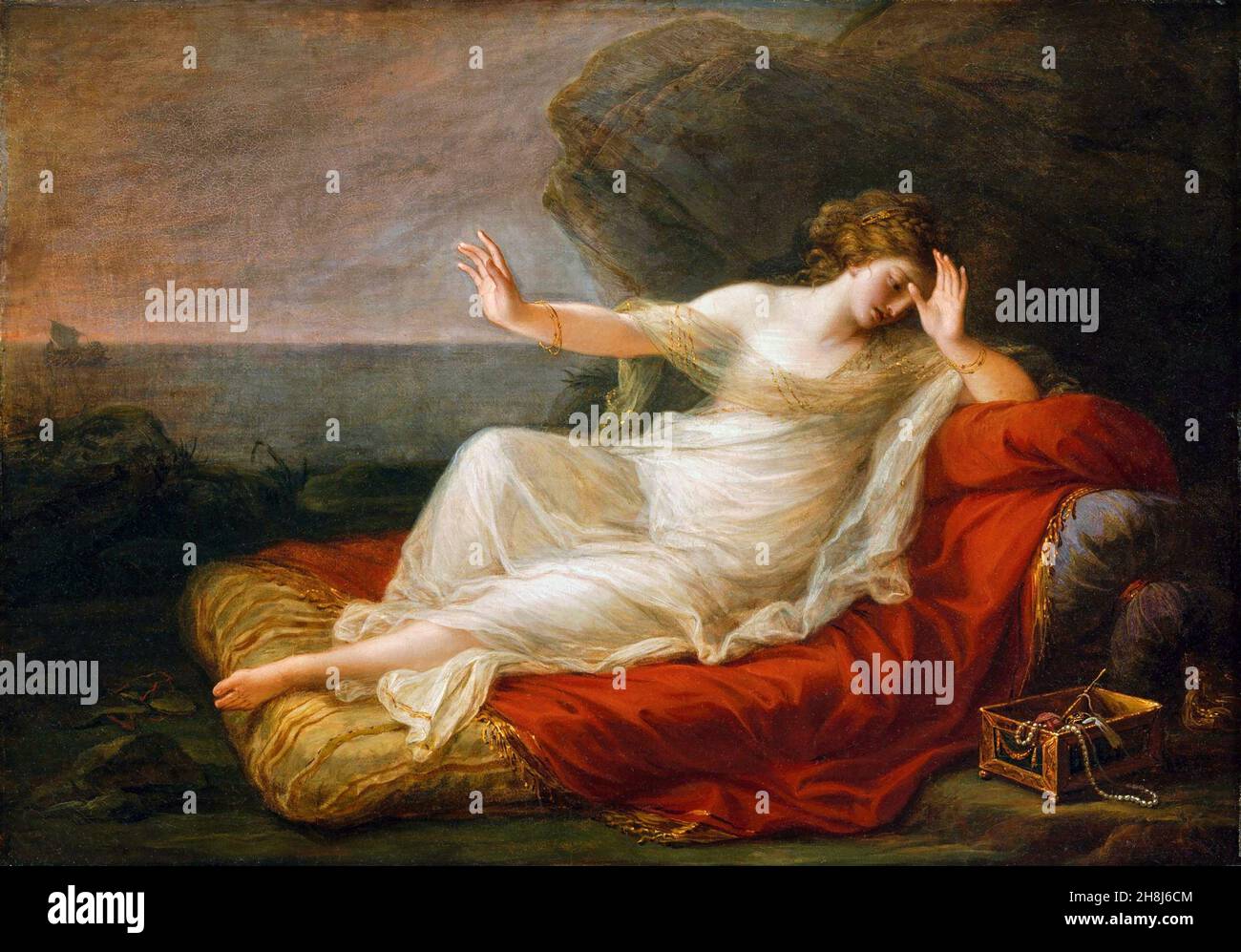 Angelica Kauffman. Ariadne Abandoned by Theseus by the Swiss painter, Maria Anna Angelika Kauffmann (1741-1807), oil on canvas, 1774 Stock Photohttps://www.alamy.com/image-license-details/?v=1https://www.alamy.com/angelica-kauffman-ariadne-abandoned-by-theseus-by-the-swiss-painter-maria-anna-angelika-kauffmann-1741-1807-oil-on-canvas-1774-image452787012.html
Angelica Kauffman. Ariadne Abandoned by Theseus by the Swiss painter, Maria Anna Angelika Kauffmann (1741-1807), oil on canvas, 1774 Stock Photohttps://www.alamy.com/image-license-details/?v=1https://www.alamy.com/angelica-kauffman-ariadne-abandoned-by-theseus-by-the-swiss-painter-maria-anna-angelika-kauffmann-1741-1807-oil-on-canvas-1774-image452787012.htmlRM2H8J6CM–Angelica Kauffman. Ariadne Abandoned by Theseus by the Swiss painter, Maria Anna Angelika Kauffmann (1741-1807), oil on canvas, 1774
 Angelica Kauffman. Ariadne Abandoned by Theseus, painting by the Swiss Neoclassical female painter Angelica Kauffmann, 1774 Stock Photohttps://www.alamy.com/image-license-details/?v=1https://www.alamy.com/angelica-kauffman-ariadne-abandoned-by-theseus-painting-by-the-swiss-neoclassical-female-painter-angelica-kauffmann-1774-image456685383.html
Angelica Kauffman. Ariadne Abandoned by Theseus, painting by the Swiss Neoclassical female painter Angelica Kauffmann, 1774 Stock Photohttps://www.alamy.com/image-license-details/?v=1https://www.alamy.com/angelica-kauffman-ariadne-abandoned-by-theseus-painting-by-the-swiss-neoclassical-female-painter-angelica-kauffmann-1774-image456685383.htmlRM2HEYPT7–Angelica Kauffman. Ariadne Abandoned by Theseus, painting by the Swiss Neoclassical female painter Angelica Kauffmann, 1774
 Sarcophagus with the myth of Dionysus and Ariadne 3th century AD (The legend of Ariadne abandoned by Theseus in Naxos and saved by the arrival of the god Dionysus lent itself to a funerary interpretation likely to support the hope of one who saw approaching death, suffered from his disappearance. The deceased assimilated to the abandoned girl wishes and hopes that the visit of the god will confer a kind of resurrection for a sixth in the hereafter, similar to the eternal sixth of the deities. ), Roman, Greek, Stock Photohttps://www.alamy.com/image-license-details/?v=1https://www.alamy.com/sarcophagus-with-the-myth-of-dionysus-and-ariadne-3th-century-ad-the-legend-of-ariadne-abandoned-by-theseus-in-naxos-and-saved-by-the-arrival-of-the-god-dionysus-lent-itself-to-a-funerary-interpretation-likely-to-support-the-hope-of-one-who-saw-approaching-death-suffered-from-his-disappearance-the-deceased-assimilated-to-the-abandoned-girl-wishes-and-hopes-that-the-visit-of-the-god-will-confer-a-kind-of-resurrection-for-a-sixth-in-the-hereafter-similar-to-the-eternal-sixth-of-the-deities-roman-greek-image264197648.html
Sarcophagus with the myth of Dionysus and Ariadne 3th century AD (The legend of Ariadne abandoned by Theseus in Naxos and saved by the arrival of the god Dionysus lent itself to a funerary interpretation likely to support the hope of one who saw approaching death, suffered from his disappearance. The deceased assimilated to the abandoned girl wishes and hopes that the visit of the god will confer a kind of resurrection for a sixth in the hereafter, similar to the eternal sixth of the deities. ), Roman, Greek, Stock Photohttps://www.alamy.com/image-license-details/?v=1https://www.alamy.com/sarcophagus-with-the-myth-of-dionysus-and-ariadne-3th-century-ad-the-legend-of-ariadne-abandoned-by-theseus-in-naxos-and-saved-by-the-arrival-of-the-god-dionysus-lent-itself-to-a-funerary-interpretation-likely-to-support-the-hope-of-one-who-saw-approaching-death-suffered-from-his-disappearance-the-deceased-assimilated-to-the-abandoned-girl-wishes-and-hopes-that-the-visit-of-the-god-will-confer-a-kind-of-resurrection-for-a-sixth-in-the-hereafter-similar-to-the-eternal-sixth-of-the-deities-roman-greek-image264197648.htmlRMW9R6P8–Sarcophagus with the myth of Dionysus and Ariadne 3th century AD (The legend of Ariadne abandoned by Theseus in Naxos and saved by the arrival of the god Dionysus lent itself to a funerary interpretation likely to support the hope of one who saw approaching death, suffered from his disappearance. The deceased assimilated to the abandoned girl wishes and hopes that the visit of the god will confer a kind of resurrection for a sixth in the hereafter, similar to the eternal sixth of the deities. ), Roman, Greek,
 Bacchus and Ariadne, A grieving Ariadne, abandoned by Theseus on the island of Naxos, under a canopy, is comforted by Bacchus who offers her a glass of wine. Bottom right: a.a. Copy after Houbraken's print from part 2 of a series of prints with symbols., print maker: anonymous, after print by: Arnold Houbraken, Northern Netherlands, 1700 - 1750, paper, etching, engraving, height 150 mm × width 200 mm, print Stock Photohttps://www.alamy.com/image-license-details/?v=1https://www.alamy.com/bacchus-and-ariadne-a-grieving-ariadne-abandoned-by-theseus-on-the-island-of-naxos-under-a-canopy-is-comforted-by-bacchus-who-offers-her-a-glass-of-wine-bottom-right-aa-copy-after-houbrakens-print-from-part-2-of-a-series-of-prints-with-symbols-print-maker-anonymous-after-print-by-arnold-houbraken-northern-netherlands-1700-1750-paper-etching-engraving-height-150-mm-width-200-mm-print-image599444279.html
Bacchus and Ariadne, A grieving Ariadne, abandoned by Theseus on the island of Naxos, under a canopy, is comforted by Bacchus who offers her a glass of wine. Bottom right: a.a. Copy after Houbraken's print from part 2 of a series of prints with symbols., print maker: anonymous, after print by: Arnold Houbraken, Northern Netherlands, 1700 - 1750, paper, etching, engraving, height 150 mm × width 200 mm, print Stock Photohttps://www.alamy.com/image-license-details/?v=1https://www.alamy.com/bacchus-and-ariadne-a-grieving-ariadne-abandoned-by-theseus-on-the-island-of-naxos-under-a-canopy-is-comforted-by-bacchus-who-offers-her-a-glass-of-wine-bottom-right-aa-copy-after-houbrakens-print-from-part-2-of-a-series-of-prints-with-symbols-print-maker-anonymous-after-print-by-arnold-houbraken-northern-netherlands-1700-1750-paper-etching-engraving-height-150-mm-width-200-mm-print-image599444279.htmlRM2WR7187–Bacchus and Ariadne, A grieving Ariadne, abandoned by Theseus on the island of Naxos, under a canopy, is comforted by Bacchus who offers her a glass of wine. Bottom right: a.a. Copy after Houbraken's print from part 2 of a series of prints with symbols., print maker: anonymous, after print by: Arnold Houbraken, Northern Netherlands, 1700 - 1750, paper, etching, engraving, height 150 mm × width 200 mm, print
 . Ariadne Abandoned by Theseus . 1774 358 Angelica Kauffmann - Ariadne Abandoned by Theseus - Google Art Project Stock Photohttps://www.alamy.com/image-license-details/?v=1https://www.alamy.com/ariadne-abandoned-by-theseus-1774-358-angelica-kauffmann-ariadne-abandoned-by-theseus-google-art-project-image189226775.html
. Ariadne Abandoned by Theseus . 1774 358 Angelica Kauffmann - Ariadne Abandoned by Theseus - Google Art Project Stock Photohttps://www.alamy.com/image-license-details/?v=1https://www.alamy.com/ariadne-abandoned-by-theseus-1774-358-angelica-kauffmann-ariadne-abandoned-by-theseus-google-art-project-image189226775.htmlRMMYT0K3–. Ariadne Abandoned by Theseus . 1774 358 Angelica Kauffmann - Ariadne Abandoned by Theseus - Google Art Project
 Angelica Kauffmann, Ariadne Abandoned by Theseus, 1774 Stock Photohttps://www.alamy.com/image-license-details/?v=1https://www.alamy.com/stock-photo-angelica-kauffmann-ariadne-abandoned-by-theseus-1774-132595971.html
Angelica Kauffmann, Ariadne Abandoned by Theseus, 1774 Stock Photohttps://www.alamy.com/image-license-details/?v=1https://www.alamy.com/stock-photo-angelica-kauffmann-ariadne-abandoned-by-theseus-1774-132595971.htmlRMHKM7EB–Angelica Kauffmann, Ariadne Abandoned by Theseus, 1774
 Angelica Kauffmann - Ariadne Abandoned by Theseus - Stock Photohttps://www.alamy.com/image-license-details/?v=1https://www.alamy.com/angelica-kauffmann-ariadne-abandoned-by-theseus-image214732986.html
Angelica Kauffmann - Ariadne Abandoned by Theseus - Stock Photohttps://www.alamy.com/image-license-details/?v=1https://www.alamy.com/angelica-kauffmann-ariadne-abandoned-by-theseus-image214732986.htmlRMPD9X36–Angelica Kauffmann - Ariadne Abandoned by Theseus -
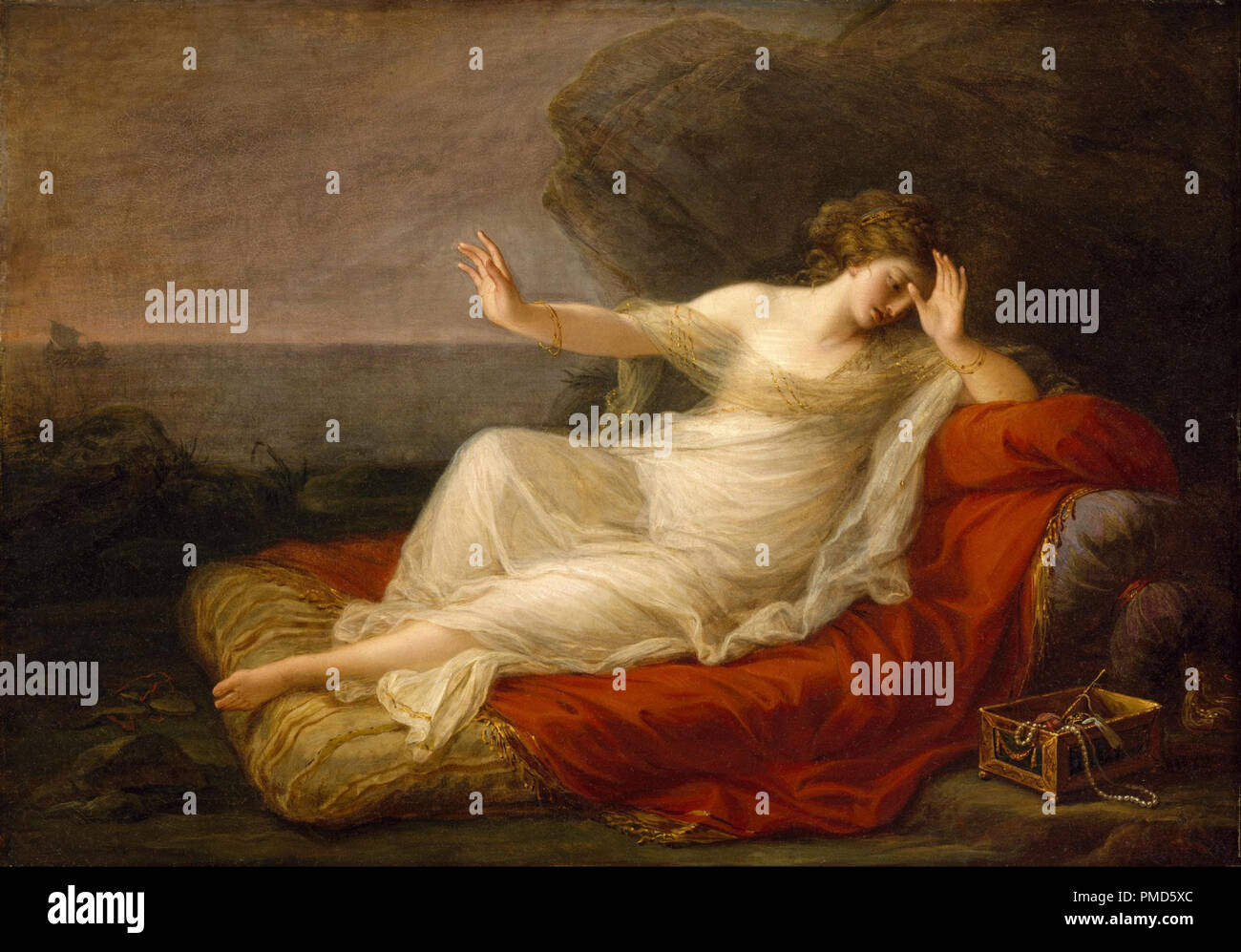 Ariadne Abandoned by Theseus. Date/Period: 1774. Painting. Oil on canvas. Height: 63.8 cm (25.1 in); Width: 90.9 cm (35.7 in). Author: Angelica Kauffman. Stock Photohttps://www.alamy.com/image-license-details/?v=1https://www.alamy.com/ariadne-abandoned-by-theseus-dateperiod-1774-painting-oil-on-canvas-height-638-cm-251-in-width-909-cm-357-in-author-angelica-kauffman-image219107572.html
Ariadne Abandoned by Theseus. Date/Period: 1774. Painting. Oil on canvas. Height: 63.8 cm (25.1 in); Width: 90.9 cm (35.7 in). Author: Angelica Kauffman. Stock Photohttps://www.alamy.com/image-license-details/?v=1https://www.alamy.com/ariadne-abandoned-by-theseus-dateperiod-1774-painting-oil-on-canvas-height-638-cm-251-in-width-909-cm-357-in-author-angelica-kauffman-image219107572.htmlRMPMD5XC–Ariadne Abandoned by Theseus. Date/Period: 1774. Painting. Oil on canvas. Height: 63.8 cm (25.1 in); Width: 90.9 cm (35.7 in). Author: Angelica Kauffman.
 Roman sarcophagus. Myth of Theseus and Ariadne. Marble. C.130-140 AD. Ariadne abandoned on the island of Naxos. Stock Photohttps://www.alamy.com/image-license-details/?v=1https://www.alamy.com/stock-photo-roman-sarcophagus-myth-of-theseus-and-ariadne-marble-c130-140-ad-ariadne-81336288.html
Roman sarcophagus. Myth of Theseus and Ariadne. Marble. C.130-140 AD. Ariadne abandoned on the island of Naxos. Stock Photohttps://www.alamy.com/image-license-details/?v=1https://www.alamy.com/stock-photo-roman-sarcophagus-myth-of-theseus-and-ariadne-marble-c130-140-ad-ariadne-81336288.htmlRMEM957C–Roman sarcophagus. Myth of Theseus and Ariadne. Marble. C.130-140 AD. Ariadne abandoned on the island of Naxos.
 Bacchus and Ariadne (title on object) Mythological love stories (series title), Bacchus comforts Ariadne, who has been abandoned by Theseus. A leopard under his feet. In the foreground a partying putto with a bunch of grapes. In the background a sailing boat (from Theseus), Bacchus finds Ariadne on Naxos, cupids: 'amores', 'amoretti', 'putti', Pieter van Gunst (mentioned on object), Amsterdam, 1659 - 1731, paper, engraving, h 421 mm × w 291 mm Stock Photohttps://www.alamy.com/image-license-details/?v=1https://www.alamy.com/bacchus-and-ariadne-title-on-object-mythological-love-stories-series-title-bacchus-comforts-ariadne-who-has-been-abandoned-by-theseus-a-leopard-under-his-feet-in-the-foreground-a-partying-putto-with-a-bunch-of-grapes-in-the-background-a-sailing-boat-from-theseus-bacchus-finds-ariadne-on-naxos-cupids-amores-amoretti-putti-pieter-van-gunst-mentioned-on-object-amsterdam-1659-1731-paper-engraving-h-421-mm-w-291-mm-image261405677.html
Bacchus and Ariadne (title on object) Mythological love stories (series title), Bacchus comforts Ariadne, who has been abandoned by Theseus. A leopard under his feet. In the foreground a partying putto with a bunch of grapes. In the background a sailing boat (from Theseus), Bacchus finds Ariadne on Naxos, cupids: 'amores', 'amoretti', 'putti', Pieter van Gunst (mentioned on object), Amsterdam, 1659 - 1731, paper, engraving, h 421 mm × w 291 mm Stock Photohttps://www.alamy.com/image-license-details/?v=1https://www.alamy.com/bacchus-and-ariadne-title-on-object-mythological-love-stories-series-title-bacchus-comforts-ariadne-who-has-been-abandoned-by-theseus-a-leopard-under-his-feet-in-the-foreground-a-partying-putto-with-a-bunch-of-grapes-in-the-background-a-sailing-boat-from-theseus-bacchus-finds-ariadne-on-naxos-cupids-amores-amoretti-putti-pieter-van-gunst-mentioned-on-object-amsterdam-1659-1731-paper-engraving-h-421-mm-w-291-mm-image261405677.htmlRMW581H1–Bacchus and Ariadne (title on object) Mythological love stories (series title), Bacchus comforts Ariadne, who has been abandoned by Theseus. A leopard under his feet. In the foreground a partying putto with a bunch of grapes. In the background a sailing boat (from Theseus), Bacchus finds Ariadne on Naxos, cupids: 'amores', 'amoretti', 'putti', Pieter van Gunst (mentioned on object), Amsterdam, 1659 - 1731, paper, engraving, h 421 mm × w 291 mm
 Ariadne Abandoned by Theseus 1959 by Thomas Rowlandson Stock Photohttps://www.alamy.com/image-license-details/?v=1https://www.alamy.com/ariadne-abandoned-by-theseus-1959-by-thomas-rowlandson-image591077468.html
Ariadne Abandoned by Theseus 1959 by Thomas Rowlandson Stock Photohttps://www.alamy.com/image-license-details/?v=1https://www.alamy.com/ariadne-abandoned-by-theseus-1959-by-thomas-rowlandson-image591077468.htmlRM2W9HW9G–Ariadne Abandoned by Theseus 1959 by Thomas Rowlandson
 Central panel fresco triclinium (dining-room) wall featuring Ariadne abandoned by Theseus on the island of Naxos framed in blue on a yellow and red g Stock Photohttps://www.alamy.com/image-license-details/?v=1https://www.alamy.com/central-panel-fresco-triclinium-dining-room-wall-featuring-ariadne-abandoned-by-theseus-on-the-island-of-naxos-framed-in-blue-on-a-yellow-and-red-g-image432141604.html
Central panel fresco triclinium (dining-room) wall featuring Ariadne abandoned by Theseus on the island of Naxos framed in blue on a yellow and red g Stock Photohttps://www.alamy.com/image-license-details/?v=1https://www.alamy.com/central-panel-fresco-triclinium-dining-room-wall-featuring-ariadne-abandoned-by-theseus-on-the-island-of-naxos-framed-in-blue-on-a-yellow-and-red-g-image432141604.htmlRM2G31N0M–Central panel fresco triclinium (dining-room) wall featuring Ariadne abandoned by Theseus on the island of Naxos framed in blue on a yellow and red g
 Ariadne abandoned by Theseus Pompeii Arianna abbandonato da Teseo. Pompei Object Type : foto carte-de-visite Objectnummer: RP-F-F24727 Manufacturer : fotograaf: Sommer & Behles (vermeld op object)fotograaf: Giorgio Sommerfotograaf: Edmondo Behles Dating: 1863 Dimensions: geheel: h 64 mm × b 103 mm Stock Photohttps://www.alamy.com/image-license-details/?v=1https://www.alamy.com/ariadne-abandoned-by-theseus-pompeii-arianna-abbandonato-da-teseo-pompei-object-type-foto-carte-de-visite-objectnummer-rp-f-f24727-manufacturer-fotograaf-sommer-behles-vermeld-op-objectfotograaf-giorgio-sommerfotograaf-edmondo-behles-dating-1863-dimensions-geheel-h-64-mm-b-103-mm-image348144947.html
Ariadne abandoned by Theseus Pompeii Arianna abbandonato da Teseo. Pompei Object Type : foto carte-de-visite Objectnummer: RP-F-F24727 Manufacturer : fotograaf: Sommer & Behles (vermeld op object)fotograaf: Giorgio Sommerfotograaf: Edmondo Behles Dating: 1863 Dimensions: geheel: h 64 mm × b 103 mm Stock Photohttps://www.alamy.com/image-license-details/?v=1https://www.alamy.com/ariadne-abandoned-by-theseus-pompeii-arianna-abbandonato-da-teseo-pompei-object-type-foto-carte-de-visite-objectnummer-rp-f-f24727-manufacturer-fotograaf-sommer-behles-vermeld-op-objectfotograaf-giorgio-sommerfotograaf-edmondo-behles-dating-1863-dimensions-geheel-h-64-mm-b-103-mm-image348144947.htmlRM2B6BAC3–Ariadne abandoned by Theseus Pompeii Arianna abbandonato da Teseo. Pompei Object Type : foto carte-de-visite Objectnummer: RP-F-F24727 Manufacturer : fotograaf: Sommer & Behles (vermeld op object)fotograaf: Giorgio Sommerfotograaf: Edmondo Behles Dating: 1863 Dimensions: geheel: h 64 mm × b 103 mm
 Angelica Kauffmann, Ariadne Abandoned by Theseus (1774), 63.8 x 90.9 cm. Stock Photohttps://www.alamy.com/image-license-details/?v=1https://www.alamy.com/angelica-kauffmann-ariadne-abandoned-by-theseus-1774-638-x-909-cm-image604063573.html
Angelica Kauffmann, Ariadne Abandoned by Theseus (1774), 63.8 x 90.9 cm. Stock Photohttps://www.alamy.com/image-license-details/?v=1https://www.alamy.com/angelica-kauffmann-ariadne-abandoned-by-theseus-1774-638-x-909-cm-image604063573.htmlRF2X2ND71–Angelica Kauffmann, Ariadne Abandoned by Theseus (1774), 63.8 x 90.9 cm.
 A grieving Ariadne, abandoned by Theseus on the island of Naxos, under a canopy, is comforted by Bacchus who offers her a glass of wine. Stock Photohttps://www.alamy.com/image-license-details/?v=1https://www.alamy.com/a-grieving-ariadne-abandoned-by-theseus-on-the-island-of-naxos-under-a-canopy-is-comforted-by-bacchus-who-offers-her-a-glass-of-wine-image488025382.html
A grieving Ariadne, abandoned by Theseus on the island of Naxos, under a canopy, is comforted by Bacchus who offers her a glass of wine. Stock Photohttps://www.alamy.com/image-license-details/?v=1https://www.alamy.com/a-grieving-ariadne-abandoned-by-theseus-on-the-island-of-naxos-under-a-canopy-is-comforted-by-bacchus-who-offers-her-a-glass-of-wine-image488025382.htmlRF2K9YD9X–A grieving Ariadne, abandoned by Theseus on the island of Naxos, under a canopy, is comforted by Bacchus who offers her a glass of wine.
 Ariadne Abandoned by Theseus (1774), oil on canvas, 63.8 x 90.9 cm., Museum of Fine Arts, Houston Angelica Kauffmann Stock Photohttps://www.alamy.com/image-license-details/?v=1https://www.alamy.com/ariadne-abandoned-by-theseus-1774-oil-on-canvas-638-x-909-cm-museum-of-fine-arts-houston-angelica-kauffmann-image603969294.html
Ariadne Abandoned by Theseus (1774), oil on canvas, 63.8 x 90.9 cm., Museum of Fine Arts, Houston Angelica Kauffmann Stock Photohttps://www.alamy.com/image-license-details/?v=1https://www.alamy.com/ariadne-abandoned-by-theseus-1774-oil-on-canvas-638-x-909-cm-museum-of-fine-arts-houston-angelica-kauffmann-image603969294.htmlRM2X2H4YX–Ariadne Abandoned by Theseus (1774), oil on canvas, 63.8 x 90.9 cm., Museum of Fine Arts, Houston Angelica Kauffmann
 Angelica Kauffmann - Ariadne Abandoned by Theseus Stock Photohttps://www.alamy.com/image-license-details/?v=1https://www.alamy.com/angelica-kauffmann-ariadne-abandoned-by-theseus-image457740583.html
Angelica Kauffmann - Ariadne Abandoned by Theseus Stock Photohttps://www.alamy.com/image-license-details/?v=1https://www.alamy.com/angelica-kauffmann-ariadne-abandoned-by-theseus-image457740583.htmlRF2HGKTNY–Angelica Kauffmann - Ariadne Abandoned by Theseus
 Kauffmann Angelica - Ariadne Abandoned by Theseus Stock Photohttps://www.alamy.com/image-license-details/?v=1https://www.alamy.com/kauffmann-angelica-ariadne-abandoned-by-theseus-image597797604.html
Kauffmann Angelica - Ariadne Abandoned by Theseus Stock Photohttps://www.alamy.com/image-license-details/?v=1https://www.alamy.com/kauffmann-angelica-ariadne-abandoned-by-theseus-image597797604.htmlRF2WMG0XC–Kauffmann Angelica - Ariadne Abandoned by Theseus
 Ariadne abandoned by Theseus on Naxos Island. The Fall of Princes , abridged. England, S. E. (probably Suffolk, possibly Bury St Edmunds); c. 1450 - c. 1460. Source: Harley 1766, f.38. Language: English. Author: BOCCACCIO, GIOVANNI. LYDGATE, JOHN. Stock Photohttps://www.alamy.com/image-license-details/?v=1https://www.alamy.com/ariadne-abandoned-by-theseus-on-naxos-island-the-fall-of-princes-abridged-england-s-e-probably-suffolk-possibly-bury-st-edmunds-c-1450-c-1460-source-harley-1766-f38-language-english-author-boccaccio-giovanni-lydgate-john-image226870161.html
Ariadne abandoned by Theseus on Naxos Island. The Fall of Princes , abridged. England, S. E. (probably Suffolk, possibly Bury St Edmunds); c. 1450 - c. 1460. Source: Harley 1766, f.38. Language: English. Author: BOCCACCIO, GIOVANNI. LYDGATE, JOHN. Stock Photohttps://www.alamy.com/image-license-details/?v=1https://www.alamy.com/ariadne-abandoned-by-theseus-on-naxos-island-the-fall-of-princes-abridged-england-s-e-probably-suffolk-possibly-bury-st-edmunds-c-1450-c-1460-source-harley-1766-f38-language-english-author-boccaccio-giovanni-lydgate-john-image226870161.htmlRMR52R5N–Ariadne abandoned by Theseus on Naxos Island. The Fall of Princes , abridged. England, S. E. (probably Suffolk, possibly Bury St Edmunds); c. 1450 - c. 1460. Source: Harley 1766, f.38. Language: English. Author: BOCCACCIO, GIOVANNI. LYDGATE, JOHN.
 Ariadne in Naxos 1877, by Evelyn De Morgan (30 August 1855 – 2 May 1919); English Pre-Raphaelite painter. Ariadne in Greek mythology, was the daughter of Minos, King of Crete, She is mostly associated with mazes and labyrinths, due to her involvement in the myths of the Minotaur and Theseus. She eloped with Theseus who abandoned Ariadne sleeping on Naxos, and Dionysus rediscovered and wedded her. Stock Photohttps://www.alamy.com/image-license-details/?v=1https://www.alamy.com/stock-photo-ariadne-in-naxos-1877-by-evelyn-de-morgan-30-august-1855-2-may-1919-76394033.html
Ariadne in Naxos 1877, by Evelyn De Morgan (30 August 1855 – 2 May 1919); English Pre-Raphaelite painter. Ariadne in Greek mythology, was the daughter of Minos, King of Crete, She is mostly associated with mazes and labyrinths, due to her involvement in the myths of the Minotaur and Theseus. She eloped with Theseus who abandoned Ariadne sleeping on Naxos, and Dionysus rediscovered and wedded her. Stock Photohttps://www.alamy.com/image-license-details/?v=1https://www.alamy.com/stock-photo-ariadne-in-naxos-1877-by-evelyn-de-morgan-30-august-1855-2-may-1919-76394033.htmlRMEC81A9–Ariadne in Naxos 1877, by Evelyn De Morgan (30 August 1855 – 2 May 1919); English Pre-Raphaelite painter. Ariadne in Greek mythology, was the daughter of Minos, King of Crete, She is mostly associated with mazes and labyrinths, due to her involvement in the myths of the Minotaur and Theseus. She eloped with Theseus who abandoned Ariadne sleeping on Naxos, and Dionysus rediscovered and wedded her.
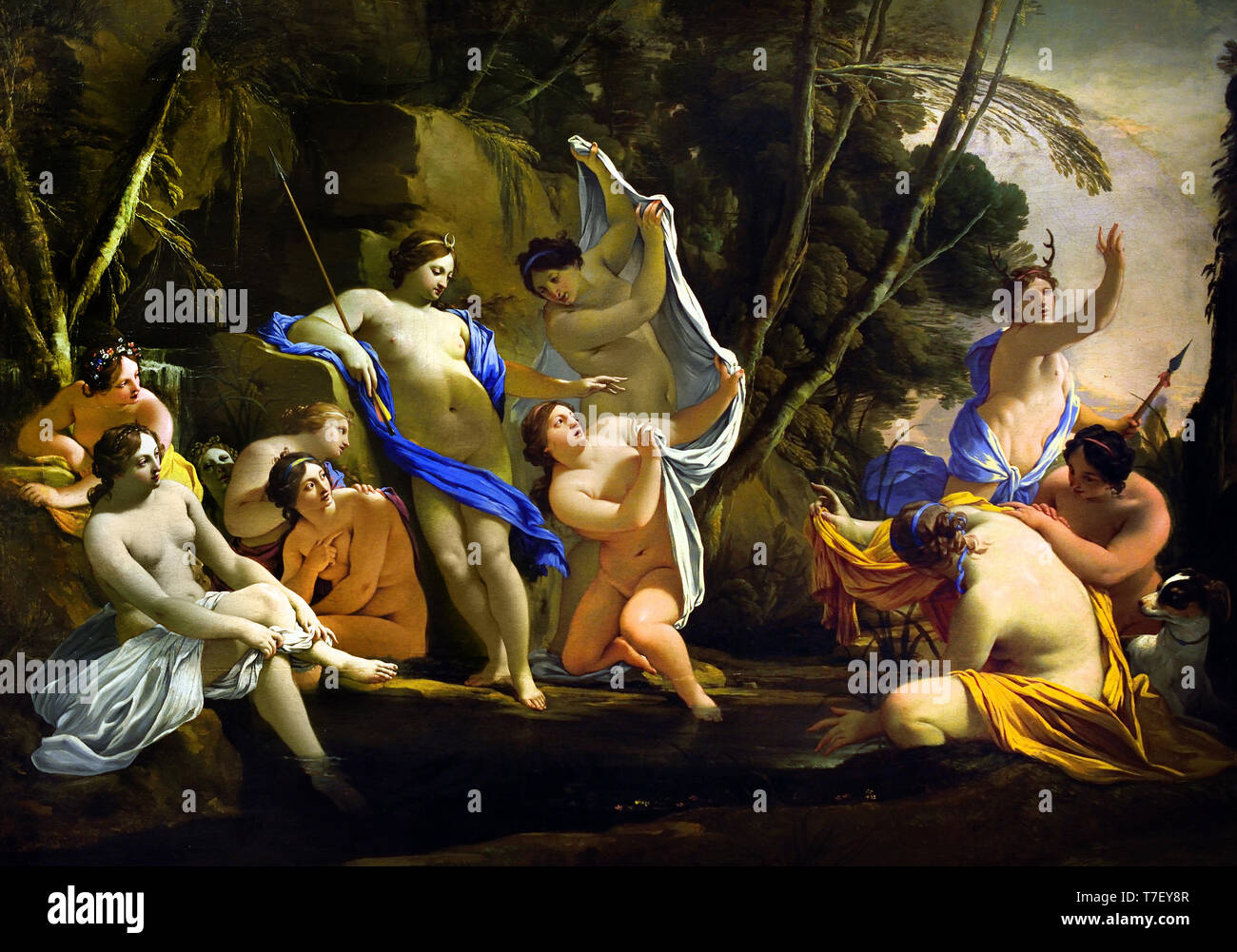 Bacchus discovering Ariane in Naxos painting by the Le Nain brothers,1630 France French )( The painting shows a young Bacchus discovering Ariane on the island of Naxos after she was abandoned by the Greek hero Theseus. ) Richard Strauss who wrote the famous Opera Ariadne auf Naxos Stock Photohttps://www.alamy.com/image-license-details/?v=1https://www.alamy.com/bacchus-discovering-ariane-in-naxos-painting-by-the-le-nain-brothers1630-france-french-the-painting-shows-a-young-bacchus-discovering-ariane-on-the-island-of-naxos-after-she-was-abandoned-by-the-greek-hero-theseus-richard-strauss-who-wrote-the-famous-opera-ariadne-auf-naxos-image245576487.html
Bacchus discovering Ariane in Naxos painting by the Le Nain brothers,1630 France French )( The painting shows a young Bacchus discovering Ariane on the island of Naxos after she was abandoned by the Greek hero Theseus. ) Richard Strauss who wrote the famous Opera Ariadne auf Naxos Stock Photohttps://www.alamy.com/image-license-details/?v=1https://www.alamy.com/bacchus-discovering-ariane-in-naxos-painting-by-the-le-nain-brothers1630-france-french-the-painting-shows-a-young-bacchus-discovering-ariane-on-the-island-of-naxos-after-she-was-abandoned-by-the-greek-hero-theseus-richard-strauss-who-wrote-the-famous-opera-ariadne-auf-naxos-image245576487.htmlRMT7EY8R–Bacchus discovering Ariane in Naxos painting by the Le Nain brothers,1630 France French )( The painting shows a young Bacchus discovering Ariane on the island of Naxos after she was abandoned by the Greek hero Theseus. ) Richard Strauss who wrote the famous Opera Ariadne auf Naxos
 Theseus and Ariadne, from 'Game of Mythology' (Jeu de la Mythologie), 1644. Stock Photohttps://www.alamy.com/image-license-details/?v=1https://www.alamy.com/theseus-and-ariadne-from-game-of-mythology-jeu-de-la-mythologie-1644-image349009554.html
Theseus and Ariadne, from 'Game of Mythology' (Jeu de la Mythologie), 1644. Stock Photohttps://www.alamy.com/image-license-details/?v=1https://www.alamy.com/theseus-and-ariadne-from-game-of-mythology-jeu-de-la-mythologie-1644-image349009554.htmlRM2B7PN6X–Theseus and Ariadne, from 'Game of Mythology' (Jeu de la Mythologie), 1644.
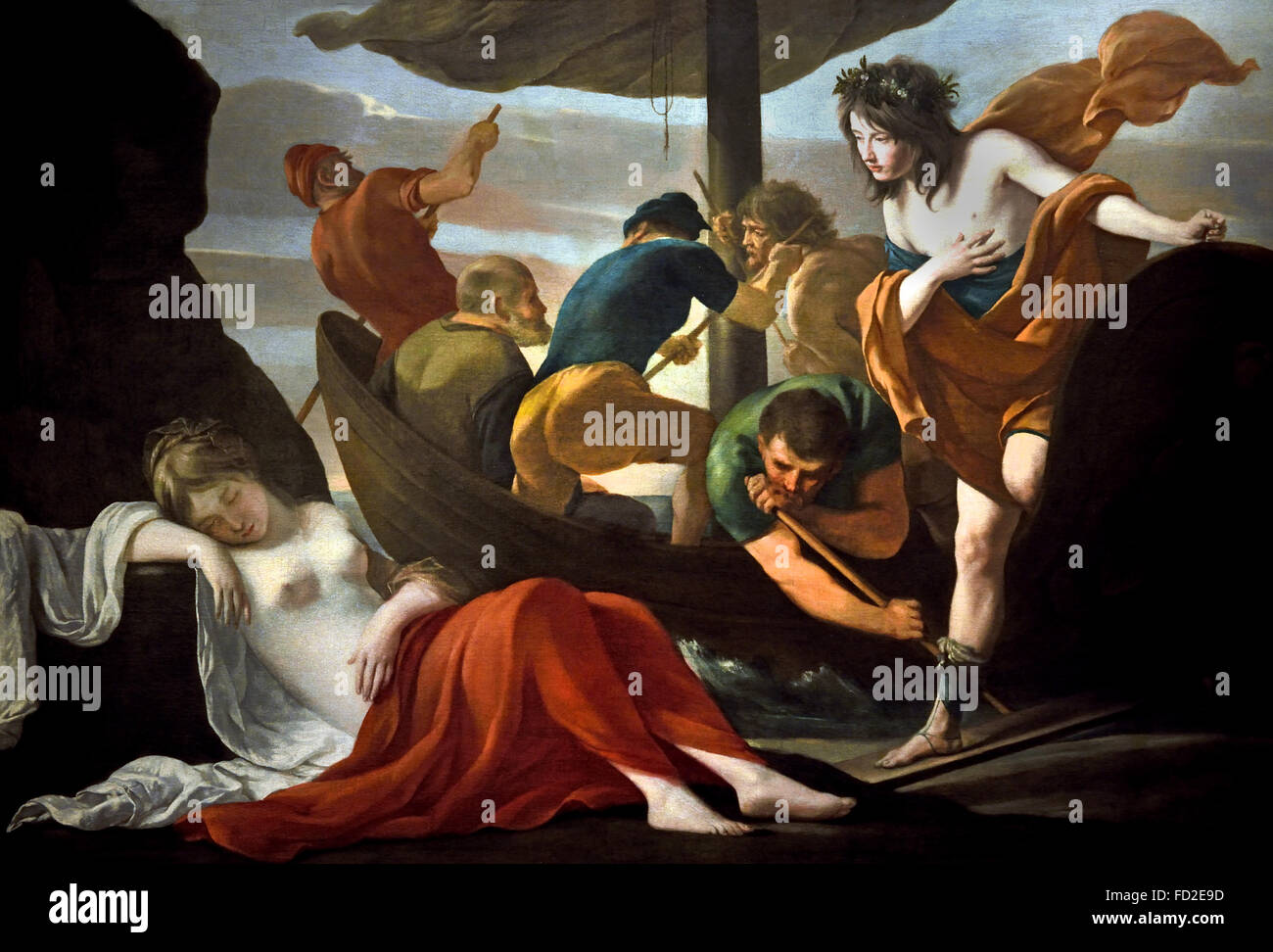 Bacchus discovering Ariane in Naxos painting by the Le Nain brothers,1630 France French )( The painting shows a young Bacchus discovering Ariane on the island of Naxos, after she was abandoned by the Greek hero Theseus. ) Richard Strauss who wrote the famous Opera Ariadne auf Naxos. Stock Photohttps://www.alamy.com/image-license-details/?v=1https://www.alamy.com/stock-photo-bacchus-discovering-ariane-in-naxos-painting-by-the-le-nain-brothers1630-94097513.html
Bacchus discovering Ariane in Naxos painting by the Le Nain brothers,1630 France French )( The painting shows a young Bacchus discovering Ariane on the island of Naxos, after she was abandoned by the Greek hero Theseus. ) Richard Strauss who wrote the famous Opera Ariadne auf Naxos. Stock Photohttps://www.alamy.com/image-license-details/?v=1https://www.alamy.com/stock-photo-bacchus-discovering-ariane-in-naxos-painting-by-the-le-nain-brothers1630-94097513.htmlRMFD2E9D–Bacchus discovering Ariane in Naxos painting by the Le Nain brothers,1630 France French )( The painting shows a young Bacchus discovering Ariane on the island of Naxos, after she was abandoned by the Greek hero Theseus. ) Richard Strauss who wrote the famous Opera Ariadne auf Naxos.
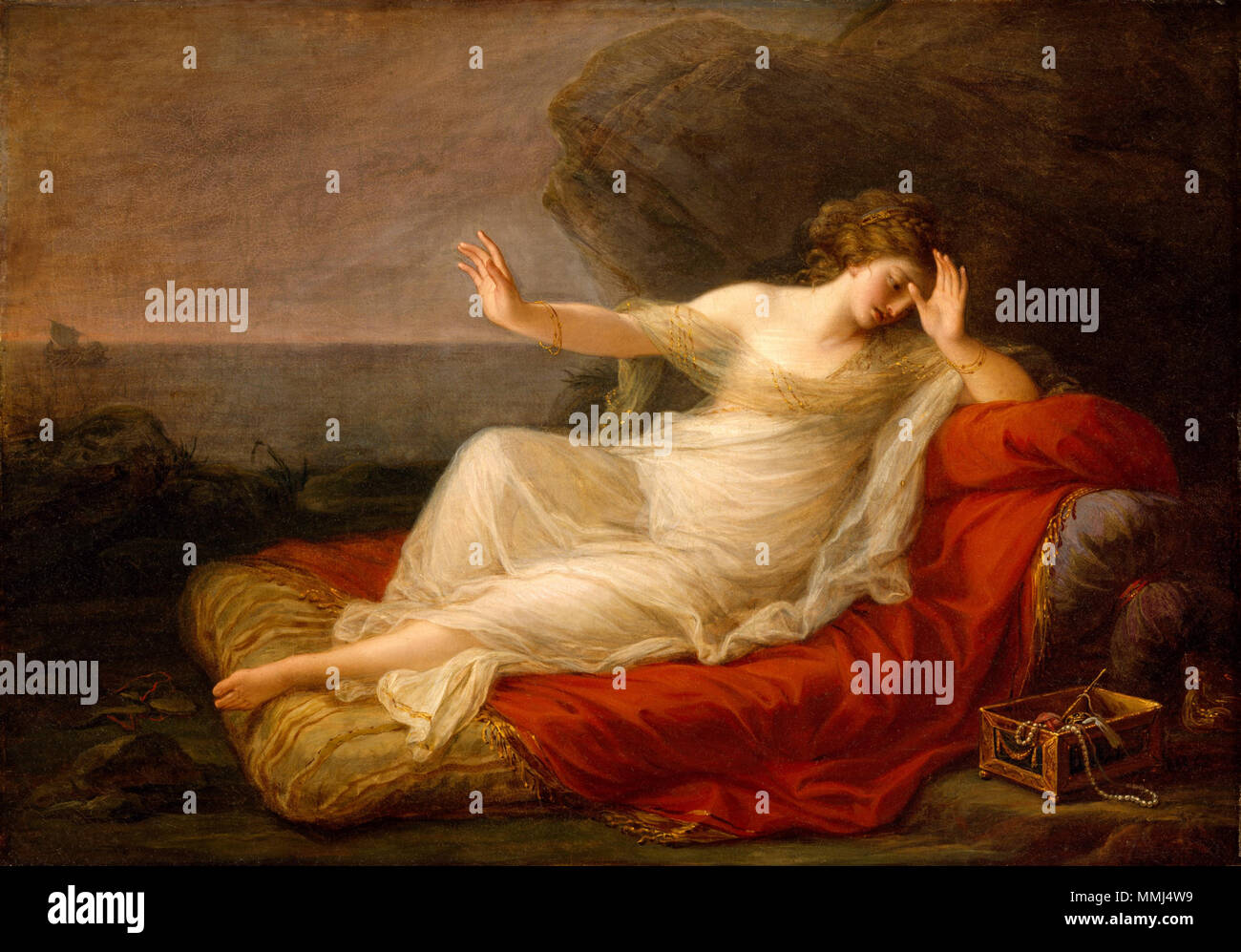 . English: Ariadne Abandoned by Theseus Ariadne Abandoned by Theseus. 1774. Angelica Kauffmann, Ariadne Abandoned by Theseus, 1774 Stock Photohttps://www.alamy.com/image-license-details/?v=1https://www.alamy.com/english-ariadne-abandoned-by-theseus-ariadne-abandoned-by-theseus-1774-angelica-kauffmann-ariadne-abandoned-by-theseus-1774-image184795781.html
. English: Ariadne Abandoned by Theseus Ariadne Abandoned by Theseus. 1774. Angelica Kauffmann, Ariadne Abandoned by Theseus, 1774 Stock Photohttps://www.alamy.com/image-license-details/?v=1https://www.alamy.com/english-ariadne-abandoned-by-theseus-ariadne-abandoned-by-theseus-1774-angelica-kauffmann-ariadne-abandoned-by-theseus-1774-image184795781.htmlRMMMJ4W9–. English: Ariadne Abandoned by Theseus Ariadne Abandoned by Theseus. 1774. Angelica Kauffmann, Ariadne Abandoned by Theseus, 1774
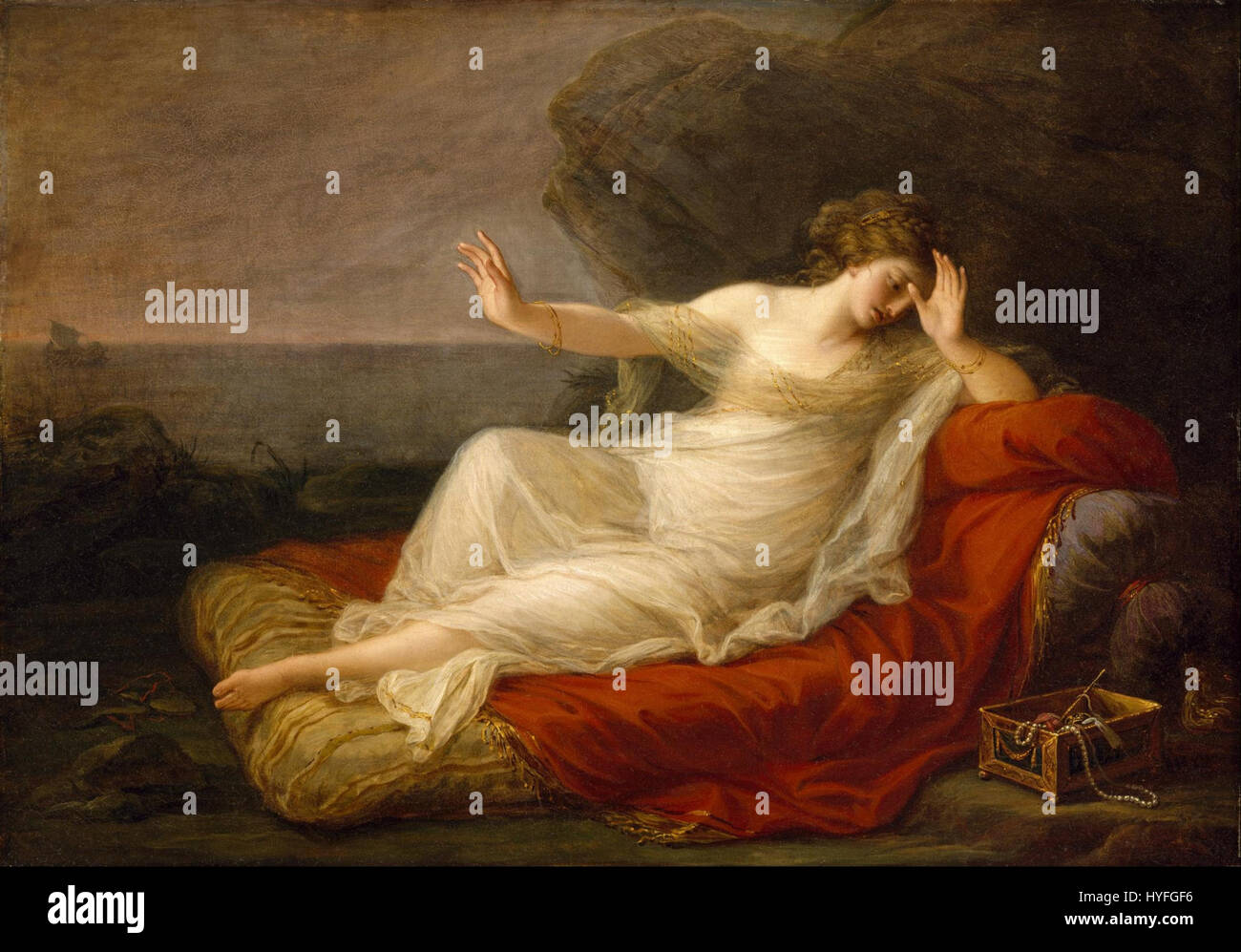 Angelica Kauffmann Ariadne Abandoned by Theseus Google Art Project Stock Photohttps://www.alamy.com/image-license-details/?v=1https://www.alamy.com/stock-photo-angelica-kauffmann-ariadne-abandoned-by-theseus-google-art-project-137410538.html
Angelica Kauffmann Ariadne Abandoned by Theseus Google Art Project Stock Photohttps://www.alamy.com/image-license-details/?v=1https://www.alamy.com/stock-photo-angelica-kauffmann-ariadne-abandoned-by-theseus-google-art-project-137410538.htmlRMHYFGF6–Angelica Kauffmann Ariadne Abandoned by Theseus Google Art Project
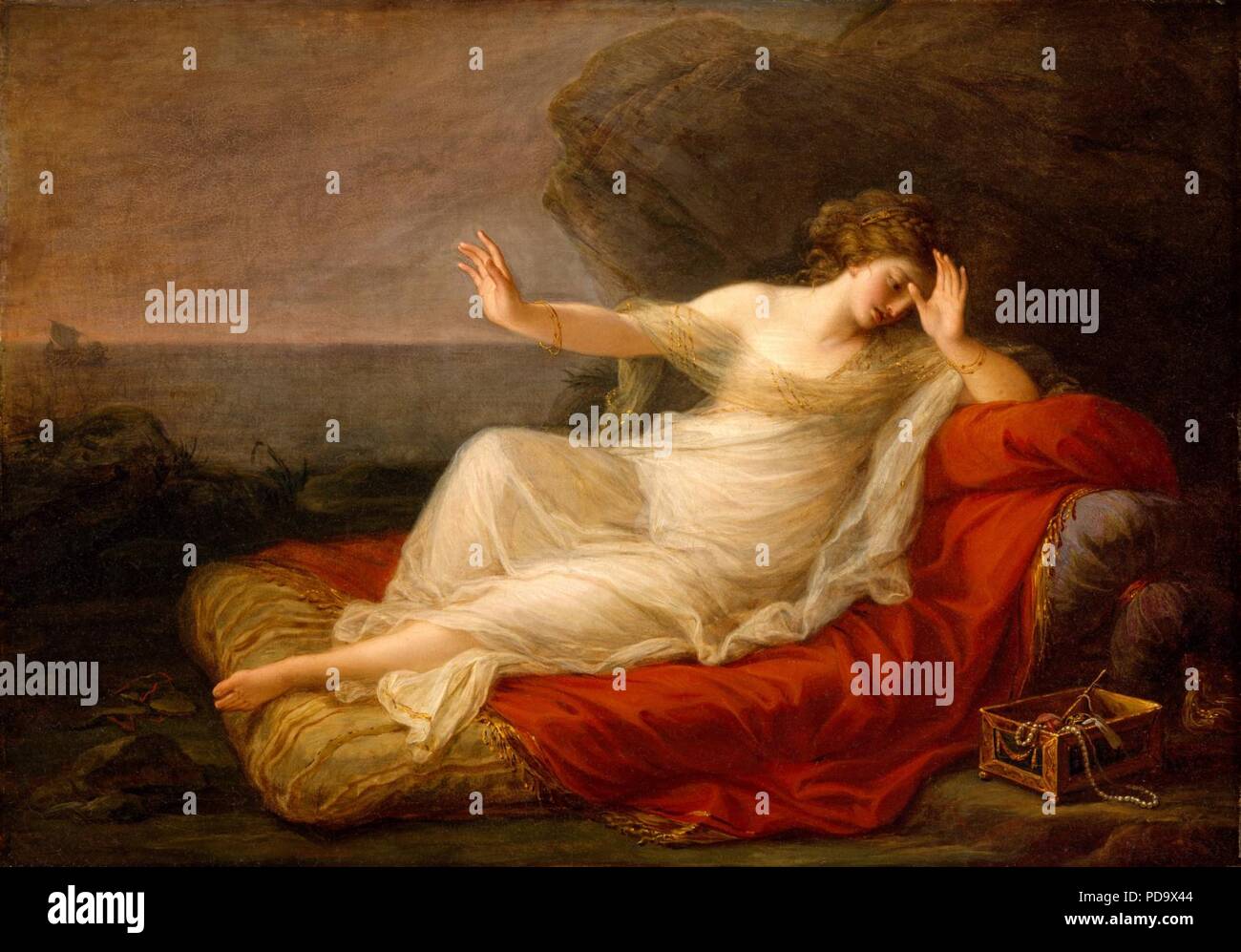 Angelica Kauffmann, Ariadne Abandoned by Theseus, 1774. Stock Photohttps://www.alamy.com/image-license-details/?v=1https://www.alamy.com/angelica-kauffmann-ariadne-abandoned-by-theseus-1774-image214733012.html
Angelica Kauffmann, Ariadne Abandoned by Theseus, 1774. Stock Photohttps://www.alamy.com/image-license-details/?v=1https://www.alamy.com/angelica-kauffmann-ariadne-abandoned-by-theseus-1774-image214733012.htmlRMPD9X44–Angelica Kauffmann, Ariadne Abandoned by Theseus, 1774.
RMPAR47C–Terracotta bell-krater (mixing bowl). Culture: Greek, South Italian, Apulian. Dimensions: H. 12 in. (30.5 cm). Date: ca. 380-360 B.C.. Obverse, satyr and maenad. Reverse, two youths The representation is interesting because the maenad, asleep in an outdoor setting, recalls the pose of Ariadne when she was found on the island of Naxos by the wine god Dionysos; she had been abandoned there by Theseus. The iconography of an 'elevated' mythological subject has been applied to members of Dionysos' retinue. Museum: Metropolitan Museum of Art, New York, USA.
 Ephesus, Turkey. The slope house mosaic of Dionysus and Ariadne.Ariadne was the daughter of King Minos of Crete. She gave to The Stock Photohttps://www.alamy.com/image-license-details/?v=1https://www.alamy.com/stock-photo-ephesus-turkey-the-slope-house-mosaic-of-dionysus-and-ariadneariadne-13768249.html
Ephesus, Turkey. The slope house mosaic of Dionysus and Ariadne.Ariadne was the daughter of King Minos of Crete. She gave to The Stock Photohttps://www.alamy.com/image-license-details/?v=1https://www.alamy.com/stock-photo-ephesus-turkey-the-slope-house-mosaic-of-dionysus-and-ariadneariadne-13768249.htmlRMAEX3GX–Ephesus, Turkey. The slope house mosaic of Dionysus and Ariadne.Ariadne was the daughter of King Minos of Crete. She gave to The
 Bacchus, surrounded with his retinue, comforts Ariadne, who was abandoned on the island of Naxos by Theseus, Bacchus comforts Ariadne Bacho Veniente tollitur tristitia, print maker: Cornelis Holsteyn, (mentioned on object), Northern Netherlands, 1628 - 1658, paper, etching, h 298 mm × w 201 mm Stock Photohttps://www.alamy.com/image-license-details/?v=1https://www.alamy.com/bacchus-surrounded-with-his-retinue-comforts-ariadne-who-was-abandoned-on-the-island-of-naxos-by-theseus-bacchus-comforts-ariadne-bacho-veniente-tollitur-tristitia-print-maker-cornelis-holsteyn-mentioned-on-object-northern-netherlands-1628-1658-paper-etching-h-298-mm-w-201-mm-image472023436.html
Bacchus, surrounded with his retinue, comforts Ariadne, who was abandoned on the island of Naxos by Theseus, Bacchus comforts Ariadne Bacho Veniente tollitur tristitia, print maker: Cornelis Holsteyn, (mentioned on object), Northern Netherlands, 1628 - 1658, paper, etching, h 298 mm × w 201 mm Stock Photohttps://www.alamy.com/image-license-details/?v=1https://www.alamy.com/bacchus-surrounded-with-his-retinue-comforts-ariadne-who-was-abandoned-on-the-island-of-naxos-by-theseus-bacchus-comforts-ariadne-bacho-veniente-tollitur-tristitia-print-maker-cornelis-holsteyn-mentioned-on-object-northern-netherlands-1628-1658-paper-etching-h-298-mm-w-201-mm-image472023436.htmlRM2JBXEKT–Bacchus, surrounded with his retinue, comforts Ariadne, who was abandoned on the island of Naxos by Theseus, Bacchus comforts Ariadne Bacho Veniente tollitur tristitia, print maker: Cornelis Holsteyn, (mentioned on object), Northern Netherlands, 1628 - 1658, paper, etching, h 298 mm × w 201 mm
 Ariadne Abandoned by Theseus 1959 by Thomas Rowlandson Stock Photohttps://www.alamy.com/image-license-details/?v=1https://www.alamy.com/ariadne-abandoned-by-theseus-1959-by-thomas-rowlandson-image591077469.html
Ariadne Abandoned by Theseus 1959 by Thomas Rowlandson Stock Photohttps://www.alamy.com/image-license-details/?v=1https://www.alamy.com/ariadne-abandoned-by-theseus-1959-by-thomas-rowlandson-image591077469.htmlRM2W9HW9H–Ariadne Abandoned by Theseus 1959 by Thomas Rowlandson
 Bacchus and Ariadne, Arnold Houbraken, Anonymous, 1700 - 1750 Stock Photohttps://www.alamy.com/image-license-details/?v=1https://www.alamy.com/bacchus-and-ariadne-arnold-houbraken-anonymous-1700-1750-image240610822.html
Bacchus and Ariadne, Arnold Houbraken, Anonymous, 1700 - 1750 Stock Photohttps://www.alamy.com/image-license-details/?v=1https://www.alamy.com/bacchus-and-ariadne-arnold-houbraken-anonymous-1700-1750-image240610822.htmlRMRYCNFJ–Bacchus and Ariadne, Arnold Houbraken, Anonymous, 1700 - 1750
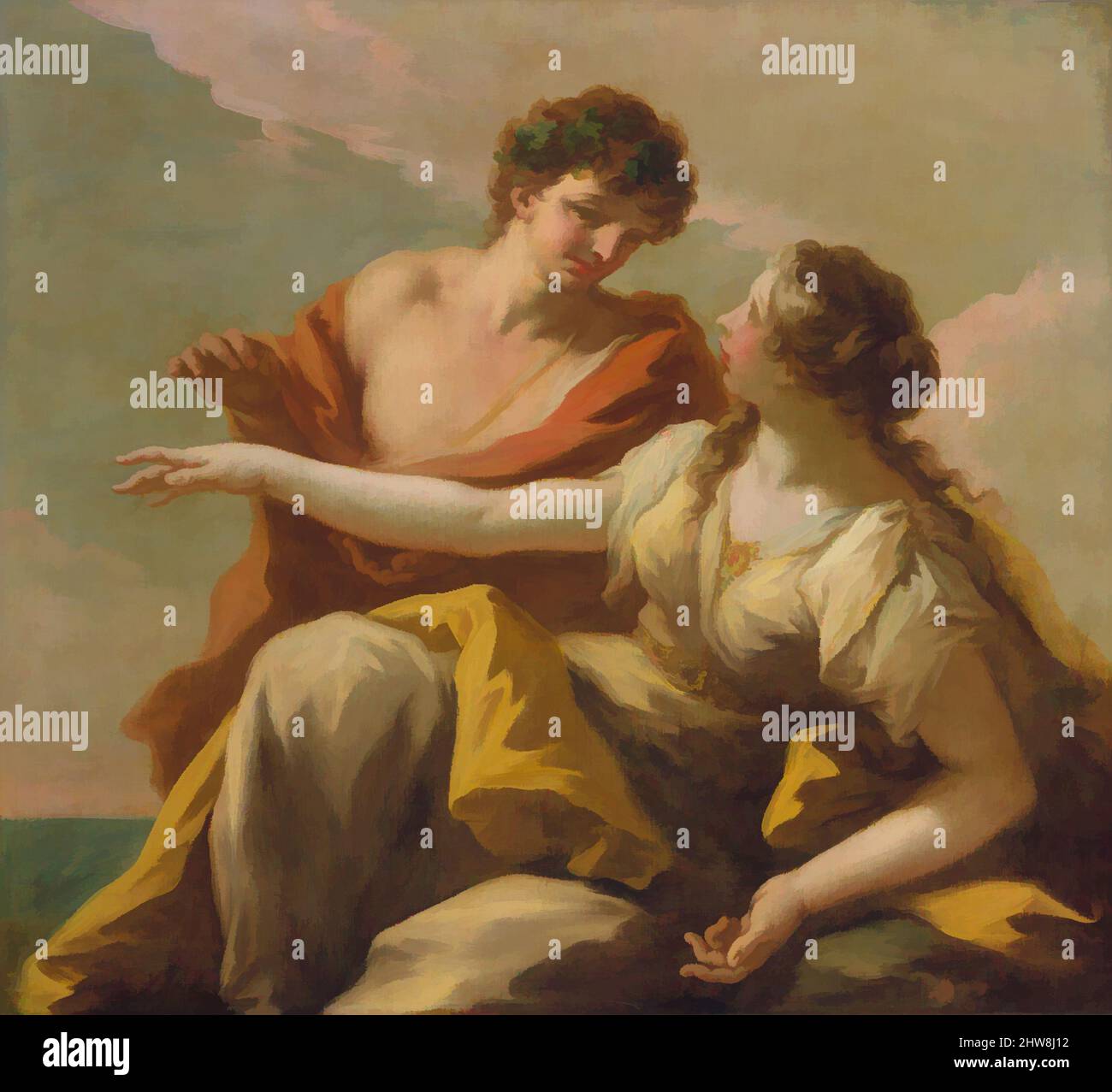 Art inspired by Bacchus and Ariadne, 1720s, Oil on canvas, 46 x 50 1/2 in. (116.8 x 128.3 cm), Paintings, Giovanni Antonio Pellegrini (Italian, Venice 1675–1741 Venice), When Bacchus arrived on the island of Naxos, he found the beautiful daughter of Minos, Ariadne, who had been, Classic works modernized by Artotop with a splash of modernity. Shapes, color and value, eye-catching visual impact on art. Emotions through freedom of artworks in a contemporary way. A timeless message pursuing a wildly creative new direction. Artists turning to the digital medium and creating the Artotop NFT Stock Photohttps://www.alamy.com/image-license-details/?v=1https://www.alamy.com/art-inspired-by-bacchus-and-ariadne-1720s-oil-on-canvas-46-x-50-12-in-1168-x-1283-cm-paintings-giovanni-antonio-pellegrini-italian-venice-16751741-venice-when-bacchus-arrived-on-the-island-of-naxos-he-found-the-beautiful-daughter-of-minos-ariadne-who-had-been-classic-works-modernized-by-artotop-with-a-splash-of-modernity-shapes-color-and-value-eye-catching-visual-impact-on-art-emotions-through-freedom-of-artworks-in-a-contemporary-way-a-timeless-message-pursuing-a-wildly-creative-new-direction-artists-turning-to-the-digital-medium-and-creating-the-artotop-nft-image463025726.html
Art inspired by Bacchus and Ariadne, 1720s, Oil on canvas, 46 x 50 1/2 in. (116.8 x 128.3 cm), Paintings, Giovanni Antonio Pellegrini (Italian, Venice 1675–1741 Venice), When Bacchus arrived on the island of Naxos, he found the beautiful daughter of Minos, Ariadne, who had been, Classic works modernized by Artotop with a splash of modernity. Shapes, color and value, eye-catching visual impact on art. Emotions through freedom of artworks in a contemporary way. A timeless message pursuing a wildly creative new direction. Artists turning to the digital medium and creating the Artotop NFT Stock Photohttps://www.alamy.com/image-license-details/?v=1https://www.alamy.com/art-inspired-by-bacchus-and-ariadne-1720s-oil-on-canvas-46-x-50-12-in-1168-x-1283-cm-paintings-giovanni-antonio-pellegrini-italian-venice-16751741-venice-when-bacchus-arrived-on-the-island-of-naxos-he-found-the-beautiful-daughter-of-minos-ariadne-who-had-been-classic-works-modernized-by-artotop-with-a-splash-of-modernity-shapes-color-and-value-eye-catching-visual-impact-on-art-emotions-through-freedom-of-artworks-in-a-contemporary-way-a-timeless-message-pursuing-a-wildly-creative-new-direction-artists-turning-to-the-digital-medium-and-creating-the-artotop-nft-image463025726.htmlRF2HW8J12–Art inspired by Bacchus and Ariadne, 1720s, Oil on canvas, 46 x 50 1/2 in. (116.8 x 128.3 cm), Paintings, Giovanni Antonio Pellegrini (Italian, Venice 1675–1741 Venice), When Bacchus arrived on the island of Naxos, he found the beautiful daughter of Minos, Ariadne, who had been, Classic works modernized by Artotop with a splash of modernity. Shapes, color and value, eye-catching visual impact on art. Emotions through freedom of artworks in a contemporary way. A timeless message pursuing a wildly creative new direction. Artists turning to the digital medium and creating the Artotop NFT
 Bacchus and Ariadne, Giovanni Antonio Pellegrini, 1720s Stock Photohttps://www.alamy.com/image-license-details/?v=1https://www.alamy.com/stock-image-bacchus-and-ariadne-giovanni-antonio-pellegrini-1720s-162561092.html
Bacchus and Ariadne, Giovanni Antonio Pellegrini, 1720s Stock Photohttps://www.alamy.com/image-license-details/?v=1https://www.alamy.com/stock-image-bacchus-and-ariadne-giovanni-antonio-pellegrini-1720s-162561092.htmlRMKCD898–Bacchus and Ariadne, Giovanni Antonio Pellegrini, 1720s
 . A grieving Ariadne, abandoned by Theseus on the island of Naxos, under a canopy, is comforted by Bacchus that offers her a glass of wine. Bottom right: A.A. Copy to the print of Houbakken from part 2 of a series of prints with symbols. Stock Photohttps://www.alamy.com/image-license-details/?v=1https://www.alamy.com/a-grieving-ariadne-abandoned-by-theseus-on-the-island-of-naxos-under-a-canopy-is-comforted-by-bacchus-that-offers-her-a-glass-of-wine-bottom-right-aa-copy-to-the-print-of-houbakken-from-part-2-of-a-series-of-prints-with-symbols-image433100409.html
. A grieving Ariadne, abandoned by Theseus on the island of Naxos, under a canopy, is comforted by Bacchus that offers her a glass of wine. Bottom right: A.A. Copy to the print of Houbakken from part 2 of a series of prints with symbols. Stock Photohttps://www.alamy.com/image-license-details/?v=1https://www.alamy.com/a-grieving-ariadne-abandoned-by-theseus-on-the-island-of-naxos-under-a-canopy-is-comforted-by-bacchus-that-offers-her-a-glass-of-wine-bottom-right-aa-copy-to-the-print-of-houbakken-from-part-2-of-a-series-of-prints-with-symbols-image433100409.htmlRM2G4HBYN–. A grieving Ariadne, abandoned by Theseus on the island of Naxos, under a canopy, is comforted by Bacchus that offers her a glass of wine. Bottom right: A.A. Copy to the print of Houbakken from part 2 of a series of prints with symbols.
 Abandoned Ariadne Ariadne, abandoned in Naxos, is crying and being comforted by the Revenge, that is pointing to the ship of theseus, long gone fresco Pompeii, Casa del Meleagro (House of Meleagro) 63-79 AD Stock Photohttps://www.alamy.com/image-license-details/?v=1https://www.alamy.com/abandoned-ariadne-ariadne-abandoned-in-naxos-is-crying-and-being-comforted-by-the-revenge-that-is-pointing-to-the-ship-of-theseus-long-gone-fresco-pompeii-casa-del-meleagro-house-of-meleagro-63-79-ad-image439797710.html
Abandoned Ariadne Ariadne, abandoned in Naxos, is crying and being comforted by the Revenge, that is pointing to the ship of theseus, long gone fresco Pompeii, Casa del Meleagro (House of Meleagro) 63-79 AD Stock Photohttps://www.alamy.com/image-license-details/?v=1https://www.alamy.com/abandoned-ariadne-ariadne-abandoned-in-naxos-is-crying-and-being-comforted-by-the-revenge-that-is-pointing-to-the-ship-of-theseus-long-gone-fresco-pompeii-casa-del-meleagro-house-of-meleagro-63-79-ad-image439797710.htmlRM2GFEED2–Abandoned Ariadne Ariadne, abandoned in Naxos, is crying and being comforted by the Revenge, that is pointing to the ship of theseus, long gone fresco Pompeii, Casa del Meleagro (House of Meleagro) 63-79 AD
 RICCI, Sebastiano (b. 1659, Belluno, d. 1734, Venezia) Bacchus and Ariadne c. 1713 Oil on canvas, 189 x 104 cm Chiswick House, London It was Ariadne, the daughter of King Minos of Crete, who helped Theseus, whom she loved, to escape from the labyrinth with the aid of a ball of string, but all she had in return was to be abandoned by him on the island of Naxos. Here Bacchus came to her rescue. Classical representations show Ariadne asleep when Bacchus arrives, as described by Philostratus. But according to Ovid she was at that moment lamenting her fate, and Renaissance and later artists gene Stock Photohttps://www.alamy.com/image-license-details/?v=1https://www.alamy.com/ricci-sebastiano-b-1659-belluno-d-1734-venezia-bacchus-and-ariadne-c-1713-oil-on-canvas-189-x-104-cm-chiswick-house-london-it-was-ariadne-the-daughter-of-king-minos-of-crete-who-helped-theseus-whom-she-loved-to-escape-from-the-labyrinth-with-the-aid-of-a-ball-of-string-but-all-she-had-in-return-was-to-be-abandoned-by-him-on-the-island-of-naxos-here-bacchus-came-to-her-rescue-classical-representations-show-ariadne-asleep-when-bacchus-arrives-as-described-by-philostratus-but-according-to-ovid-she-was-at-that-moment-lamenting-her-fate-and-renaissance-and-later-artists-gene-image604807932.html
RICCI, Sebastiano (b. 1659, Belluno, d. 1734, Venezia) Bacchus and Ariadne c. 1713 Oil on canvas, 189 x 104 cm Chiswick House, London It was Ariadne, the daughter of King Minos of Crete, who helped Theseus, whom she loved, to escape from the labyrinth with the aid of a ball of string, but all she had in return was to be abandoned by him on the island of Naxos. Here Bacchus came to her rescue. Classical representations show Ariadne asleep when Bacchus arrives, as described by Philostratus. But according to Ovid she was at that moment lamenting her fate, and Renaissance and later artists gene Stock Photohttps://www.alamy.com/image-license-details/?v=1https://www.alamy.com/ricci-sebastiano-b-1659-belluno-d-1734-venezia-bacchus-and-ariadne-c-1713-oil-on-canvas-189-x-104-cm-chiswick-house-london-it-was-ariadne-the-daughter-of-king-minos-of-crete-who-helped-theseus-whom-she-loved-to-escape-from-the-labyrinth-with-the-aid-of-a-ball-of-string-but-all-she-had-in-return-was-to-be-abandoned-by-him-on-the-island-of-naxos-here-bacchus-came-to-her-rescue-classical-representations-show-ariadne-asleep-when-bacchus-arrives-as-described-by-philostratus-but-according-to-ovid-she-was-at-that-moment-lamenting-her-fate-and-renaissance-and-later-artists-gene-image604807932.htmlRM2X3YAK8–RICCI, Sebastiano (b. 1659, Belluno, d. 1734, Venezia) Bacchus and Ariadne c. 1713 Oil on canvas, 189 x 104 cm Chiswick House, London It was Ariadne, the daughter of King Minos of Crete, who helped Theseus, whom she loved, to escape from the labyrinth with the aid of a ball of string, but all she had in return was to be abandoned by him on the island of Naxos. Here Bacchus came to her rescue. Classical representations show Ariadne asleep when Bacchus arrives, as described by Philostratus. But according to Ovid she was at that moment lamenting her fate, and Renaissance and later artists gene
 Maria Anna Angelika Catharina Kauffmann Ariadne awaked from sleep, finds herself abandoned by Theseus. Etching, punctuation technology 1778 , 1778 Stock Photohttps://www.alamy.com/image-license-details/?v=1https://www.alamy.com/maria-anna-angelika-catharina-kauffmann-ariadne-awaked-from-sleep-finds-herself-abandoned-by-theseus-etching-punctuation-technology-1778-1778-image572871031.html
Maria Anna Angelika Catharina Kauffmann Ariadne awaked from sleep, finds herself abandoned by Theseus. Etching, punctuation technology 1778 , 1778 Stock Photohttps://www.alamy.com/image-license-details/?v=1https://www.alamy.com/maria-anna-angelika-catharina-kauffmann-ariadne-awaked-from-sleep-finds-herself-abandoned-by-theseus-etching-punctuation-technology-1778-1778-image572871031.htmlRM2T80ERK–Maria Anna Angelika Catharina Kauffmann Ariadne awaked from sleep, finds herself abandoned by Theseus. Etching, punctuation technology 1778 , 1778
 Bacchus and Ariadne (title on object) Mythological love stories (series title), Bacchus comforts Ariadne, who has been abandoned by Theseus. A leopard under his feet. In the foreground a partying putto with a bunch of grapes. In the background a sailing boat (from Theseus), Bacchus finds Ariadne on Naxos, cupids: 'amores', 'amoretti', 'putti', Pieter van Gunst (mentioned on object), Amsterdam, 1659 - 1731, paper, engraving, h 421 mm × w 291 mm, Reimagined by Gibon, design of warm cheerful glowing of brightness and light rays radiance. Classic art reinvented with a modern twist. Photography ins Stock Photohttps://www.alamy.com/image-license-details/?v=1https://www.alamy.com/bacchus-and-ariadne-title-on-object-mythological-love-stories-series-title-bacchus-comforts-ariadne-who-has-been-abandoned-by-theseus-a-leopard-under-his-feet-in-the-foreground-a-partying-putto-with-a-bunch-of-grapes-in-the-background-a-sailing-boat-from-theseus-bacchus-finds-ariadne-on-naxos-cupids-amores-amoretti-putti-pieter-van-gunst-mentioned-on-object-amsterdam-1659-1731-paper-engraving-h-421-mm-w-291-mm-reimagined-by-gibon-design-of-warm-cheerful-glowing-of-brightness-and-light-rays-radiance-classic-art-reinvented-with-a-modern-twist-photography-ins-image350009094.html
Bacchus and Ariadne (title on object) Mythological love stories (series title), Bacchus comforts Ariadne, who has been abandoned by Theseus. A leopard under his feet. In the foreground a partying putto with a bunch of grapes. In the background a sailing boat (from Theseus), Bacchus finds Ariadne on Naxos, cupids: 'amores', 'amoretti', 'putti', Pieter van Gunst (mentioned on object), Amsterdam, 1659 - 1731, paper, engraving, h 421 mm × w 291 mm, Reimagined by Gibon, design of warm cheerful glowing of brightness and light rays radiance. Classic art reinvented with a modern twist. Photography ins Stock Photohttps://www.alamy.com/image-license-details/?v=1https://www.alamy.com/bacchus-and-ariadne-title-on-object-mythological-love-stories-series-title-bacchus-comforts-ariadne-who-has-been-abandoned-by-theseus-a-leopard-under-his-feet-in-the-foreground-a-partying-putto-with-a-bunch-of-grapes-in-the-background-a-sailing-boat-from-theseus-bacchus-finds-ariadne-on-naxos-cupids-amores-amoretti-putti-pieter-van-gunst-mentioned-on-object-amsterdam-1659-1731-paper-engraving-h-421-mm-w-291-mm-reimagined-by-gibon-design-of-warm-cheerful-glowing-of-brightness-and-light-rays-radiance-classic-art-reinvented-with-a-modern-twist-photography-ins-image350009094.htmlRF2B9C84P–Bacchus and Ariadne (title on object) Mythological love stories (series title), Bacchus comforts Ariadne, who has been abandoned by Theseus. A leopard under his feet. In the foreground a partying putto with a bunch of grapes. In the background a sailing boat (from Theseus), Bacchus finds Ariadne on Naxos, cupids: 'amores', 'amoretti', 'putti', Pieter van Gunst (mentioned on object), Amsterdam, 1659 - 1731, paper, engraving, h 421 mm × w 291 mm, Reimagined by Gibon, design of warm cheerful glowing of brightness and light rays radiance. Classic art reinvented with a modern twist. Photography ins
 Bacchus and Ariadne, Arnold Houbraken, Anonymous, 1700 - 1750 Stock Photohttps://www.alamy.com/image-license-details/?v=1https://www.alamy.com/stock-photo-bacchus-and-ariadne-arnold-houbraken-anonymous-1700-1750-104900258.html
Bacchus and Ariadne, Arnold Houbraken, Anonymous, 1700 - 1750 Stock Photohttps://www.alamy.com/image-license-details/?v=1https://www.alamy.com/stock-photo-bacchus-and-ariadne-arnold-houbraken-anonymous-1700-1750-104900258.htmlRMG2JH9P–Bacchus and Ariadne, Arnold Houbraken, Anonymous, 1700 - 1750
 Art inspired by Terracotta bell-krater (bowl for mixing wine and water), Classical, late 5th century B.C.–early 4th century B.C., Greek, Attic, Terracotta; red-figure, Height: 13 3/4in. (34.9cm), Diam.: 14 3/8 in. (36.5 cm), Vases, Obverse, Ariadne and two satyrs, Reverse, three youths, Classic works modernized by Artotop with a splash of modernity. Shapes, color and value, eye-catching visual impact on art. Emotions through freedom of artworks in a contemporary way. A timeless message pursuing a wildly creative new direction. Artists turning to the digital medium and creating the Artotop NFT Stock Photohttps://www.alamy.com/image-license-details/?v=1https://www.alamy.com/art-inspired-by-terracotta-bell-krater-bowl-for-mixing-wine-and-water-classical-late-5th-century-bcearly-4th-century-bc-greek-attic-terracotta-red-figure-height-13-34in-349cm-diam-14-38-in-365-cm-vases-obverse-ariadne-and-two-satyrs-reverse-three-youths-classic-works-modernized-by-artotop-with-a-splash-of-modernity-shapes-color-and-value-eye-catching-visual-impact-on-art-emotions-through-freedom-of-artworks-in-a-contemporary-way-a-timeless-message-pursuing-a-wildly-creative-new-direction-artists-turning-to-the-digital-medium-and-creating-the-artotop-nft-image462933678.html
Art inspired by Terracotta bell-krater (bowl for mixing wine and water), Classical, late 5th century B.C.–early 4th century B.C., Greek, Attic, Terracotta; red-figure, Height: 13 3/4in. (34.9cm), Diam.: 14 3/8 in. (36.5 cm), Vases, Obverse, Ariadne and two satyrs, Reverse, three youths, Classic works modernized by Artotop with a splash of modernity. Shapes, color and value, eye-catching visual impact on art. Emotions through freedom of artworks in a contemporary way. A timeless message pursuing a wildly creative new direction. Artists turning to the digital medium and creating the Artotop NFT Stock Photohttps://www.alamy.com/image-license-details/?v=1https://www.alamy.com/art-inspired-by-terracotta-bell-krater-bowl-for-mixing-wine-and-water-classical-late-5th-century-bcearly-4th-century-bc-greek-attic-terracotta-red-figure-height-13-34in-349cm-diam-14-38-in-365-cm-vases-obverse-ariadne-and-two-satyrs-reverse-three-youths-classic-works-modernized-by-artotop-with-a-splash-of-modernity-shapes-color-and-value-eye-catching-visual-impact-on-art-emotions-through-freedom-of-artworks-in-a-contemporary-way-a-timeless-message-pursuing-a-wildly-creative-new-direction-artists-turning-to-the-digital-medium-and-creating-the-artotop-nft-image462933678.htmlRF2HW4CHJ–Art inspired by Terracotta bell-krater (bowl for mixing wine and water), Classical, late 5th century B.C.–early 4th century B.C., Greek, Attic, Terracotta; red-figure, Height: 13 3/4in. (34.9cm), Diam.: 14 3/8 in. (36.5 cm), Vases, Obverse, Ariadne and two satyrs, Reverse, three youths, Classic works modernized by Artotop with a splash of modernity. Shapes, color and value, eye-catching visual impact on art. Emotions through freedom of artworks in a contemporary way. A timeless message pursuing a wildly creative new direction. Artists turning to the digital medium and creating the Artotop NFT
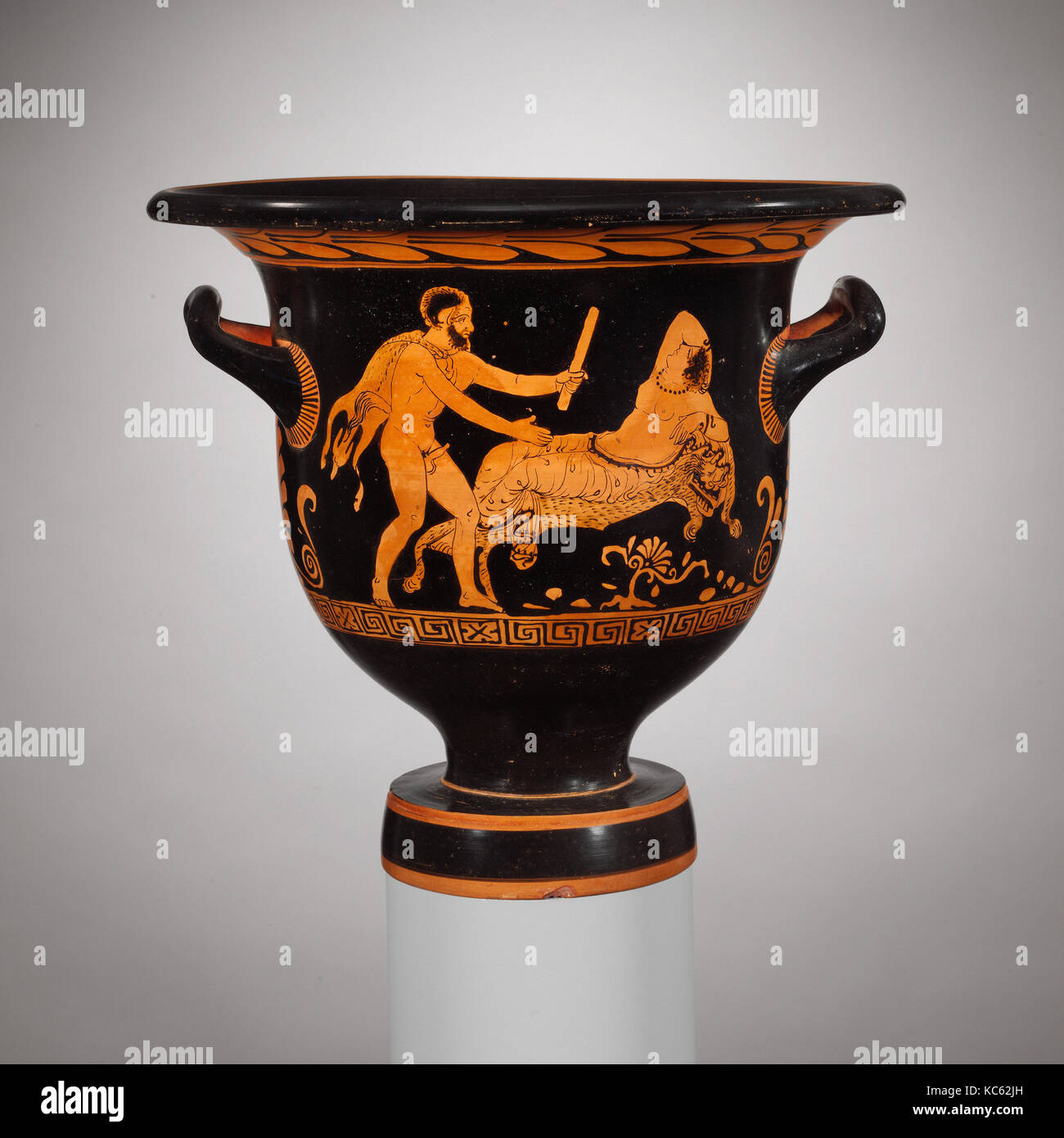 Terracotta bell-krater (mixing bowl), ca. 380–360 B.C Stock Photohttps://www.alamy.com/image-license-details/?v=1https://www.alamy.com/stock-image-terracotta-bell-krater-mixing-bowl-ca-380360-bc-162402985.html
Terracotta bell-krater (mixing bowl), ca. 380–360 B.C Stock Photohttps://www.alamy.com/image-license-details/?v=1https://www.alamy.com/stock-image-terracotta-bell-krater-mixing-bowl-ca-380360-bc-162402985.htmlRMKC62JH–Terracotta bell-krater (mixing bowl), ca. 380–360 B.C
 Bacchus and Ariadne, Arnold Houbraken, Anonymous, 1700 - 1750. Reimagined by Gibon. Classic art with a modern twist reimagined Stock Photohttps://www.alamy.com/image-license-details/?v=1https://www.alamy.com/bacchus-and-ariadne-arnold-houbraken-anonymous-1700-1750-reimagined-by-gibon-classic-art-with-a-modern-twist-reimagined-image230490986.html
Bacchus and Ariadne, Arnold Houbraken, Anonymous, 1700 - 1750. Reimagined by Gibon. Classic art with a modern twist reimagined Stock Photohttps://www.alamy.com/image-license-details/?v=1https://www.alamy.com/bacchus-and-ariadne-arnold-houbraken-anonymous-1700-1750-reimagined-by-gibon-classic-art-with-a-modern-twist-reimagined-image230490986.htmlRFRAYNGX–Bacchus and Ariadne, Arnold Houbraken, Anonymous, 1700 - 1750. Reimagined by Gibon. Classic art with a modern twist reimagined
 Angelica Kauffmann - Ariadne Abandoned by Theseus - Stock Photohttps://www.alamy.com/image-license-details/?v=1https://www.alamy.com/stock-photo-angelica-kauffmann-ariadne-abandoned-by-theseus-146492599.html
Angelica Kauffmann - Ariadne Abandoned by Theseus - Stock Photohttps://www.alamy.com/image-license-details/?v=1https://www.alamy.com/stock-photo-angelica-kauffmann-ariadne-abandoned-by-theseus-146492599.htmlRMJE98PF–Angelica Kauffmann - Ariadne Abandoned by Theseus -
 VI.15.1 Pompeii. May 2017. North wall of bedroom on left of main entrance, with painting of Ariadne being abandoned by Theseus.. Stock Photohttps://www.alamy.com/image-license-details/?v=1https://www.alamy.com/vi151-pompeii-may-2017-north-wall-of-bedroom-on-left-of-main-entrance-with-painting-of-ariadne-being-abandoned-by-theseus-image573345576.html
VI.15.1 Pompeii. May 2017. North wall of bedroom on left of main entrance, with painting of Ariadne being abandoned by Theseus.. Stock Photohttps://www.alamy.com/image-license-details/?v=1https://www.alamy.com/vi151-pompeii-may-2017-north-wall-of-bedroom-on-left-of-main-entrance-with-painting-of-ariadne-being-abandoned-by-theseus-image573345576.htmlRM2T8P43M–VI.15.1 Pompeii. May 2017. North wall of bedroom on left of main entrance, with painting of Ariadne being abandoned by Theseus..
 Bacchus and Ariadne. Artist: Giovanni Antonio Pellegrini (Italian, Venice 1675-1741 Venice). Dimensions: 46 x 50 1/2 in. (116.8 x 128.3 cm). Date: 1720s. When Bacchus arrived on the island of Naxos, he found the beautiful daughter of Minos, Ariadne, who had been abandoned by Theseus. Bacchus married her and her crown was transformed into a constellation by Jupiter. In the present picture Bacchus, wearing vine leaves in his hair, places a ring on Ariadne's finger. The subject was treated by Pellegrini a number of times. The present picture may date from after 1721, following Pellegrini's retur Stock Photohttps://www.alamy.com/image-license-details/?v=1https://www.alamy.com/bacchus-and-ariadne-artist-giovanni-antonio-pellegrini-italian-venice-1675-1741-venice-dimensions-46-x-50-12-in-1168-x-1283-cm-date-1720s-when-bacchus-arrived-on-the-island-of-naxos-he-found-the-beautiful-daughter-of-minos-ariadne-who-had-been-abandoned-by-theseus-bacchus-married-her-and-her-crown-was-transformed-into-a-constellation-by-jupiter-in-the-present-picture-bacchus-wearing-vine-leaves-in-his-hair-places-a-ring-on-ariadnes-finger-the-subject-was-treated-by-pellegrini-a-number-of-times-the-present-picture-may-date-from-after-1721-following-pellegrinis-retur-image212849577.html
Bacchus and Ariadne. Artist: Giovanni Antonio Pellegrini (Italian, Venice 1675-1741 Venice). Dimensions: 46 x 50 1/2 in. (116.8 x 128.3 cm). Date: 1720s. When Bacchus arrived on the island of Naxos, he found the beautiful daughter of Minos, Ariadne, who had been abandoned by Theseus. Bacchus married her and her crown was transformed into a constellation by Jupiter. In the present picture Bacchus, wearing vine leaves in his hair, places a ring on Ariadne's finger. The subject was treated by Pellegrini a number of times. The present picture may date from after 1721, following Pellegrini's retur Stock Photohttps://www.alamy.com/image-license-details/?v=1https://www.alamy.com/bacchus-and-ariadne-artist-giovanni-antonio-pellegrini-italian-venice-1675-1741-venice-dimensions-46-x-50-12-in-1168-x-1283-cm-date-1720s-when-bacchus-arrived-on-the-island-of-naxos-he-found-the-beautiful-daughter-of-minos-ariadne-who-had-been-abandoned-by-theseus-bacchus-married-her-and-her-crown-was-transformed-into-a-constellation-by-jupiter-in-the-present-picture-bacchus-wearing-vine-leaves-in-his-hair-places-a-ring-on-ariadnes-finger-the-subject-was-treated-by-pellegrini-a-number-of-times-the-present-picture-may-date-from-after-1721-following-pellegrinis-retur-image212849577.htmlRMPA83PH–Bacchus and Ariadne. Artist: Giovanni Antonio Pellegrini (Italian, Venice 1675-1741 Venice). Dimensions: 46 x 50 1/2 in. (116.8 x 128.3 cm). Date: 1720s. When Bacchus arrived on the island of Naxos, he found the beautiful daughter of Minos, Ariadne, who had been abandoned by Theseus. Bacchus married her and her crown was transformed into a constellation by Jupiter. In the present picture Bacchus, wearing vine leaves in his hair, places a ring on Ariadne's finger. The subject was treated by Pellegrini a number of times. The present picture may date from after 1721, following Pellegrini's retur
 Art inspired by Terracotta bell-krater (mixing bowl), Late Classical, ca. 380–360 B.C., Greek, South Italian, Apulian, Terracotta; red-figure, H. 12 in. (30.5 cm), Vases, Obverse, satyr and maenad. Reverse, two youths. The representation is interesting because the maenad, asleep in an, Classic works modernized by Artotop with a splash of modernity. Shapes, color and value, eye-catching visual impact on art. Emotions through freedom of artworks in a contemporary way. A timeless message pursuing a wildly creative new direction. Artists turning to the digital medium and creating the Artotop NFT Stock Photohttps://www.alamy.com/image-license-details/?v=1https://www.alamy.com/art-inspired-by-terracotta-bell-krater-mixing-bowl-late-classical-ca-380360-bc-greek-south-italian-apulian-terracotta-red-figure-h-12-in-305-cm-vases-obverse-satyr-and-maenad-reverse-two-youths-the-representation-is-interesting-because-the-maenad-asleep-in-an-classic-works-modernized-by-artotop-with-a-splash-of-modernity-shapes-color-and-value-eye-catching-visual-impact-on-art-emotions-through-freedom-of-artworks-in-a-contemporary-way-a-timeless-message-pursuing-a-wildly-creative-new-direction-artists-turning-to-the-digital-medium-and-creating-the-artotop-nft-image462934132.html
Art inspired by Terracotta bell-krater (mixing bowl), Late Classical, ca. 380–360 B.C., Greek, South Italian, Apulian, Terracotta; red-figure, H. 12 in. (30.5 cm), Vases, Obverse, satyr and maenad. Reverse, two youths. The representation is interesting because the maenad, asleep in an, Classic works modernized by Artotop with a splash of modernity. Shapes, color and value, eye-catching visual impact on art. Emotions through freedom of artworks in a contemporary way. A timeless message pursuing a wildly creative new direction. Artists turning to the digital medium and creating the Artotop NFT Stock Photohttps://www.alamy.com/image-license-details/?v=1https://www.alamy.com/art-inspired-by-terracotta-bell-krater-mixing-bowl-late-classical-ca-380360-bc-greek-south-italian-apulian-terracotta-red-figure-h-12-in-305-cm-vases-obverse-satyr-and-maenad-reverse-two-youths-the-representation-is-interesting-because-the-maenad-asleep-in-an-classic-works-modernized-by-artotop-with-a-splash-of-modernity-shapes-color-and-value-eye-catching-visual-impact-on-art-emotions-through-freedom-of-artworks-in-a-contemporary-way-a-timeless-message-pursuing-a-wildly-creative-new-direction-artists-turning-to-the-digital-medium-and-creating-the-artotop-nft-image462934132.htmlRF2HW4D5T–Art inspired by Terracotta bell-krater (mixing bowl), Late Classical, ca. 380–360 B.C., Greek, South Italian, Apulian, Terracotta; red-figure, H. 12 in. (30.5 cm), Vases, Obverse, satyr and maenad. Reverse, two youths. The representation is interesting because the maenad, asleep in an, Classic works modernized by Artotop with a splash of modernity. Shapes, color and value, eye-catching visual impact on art. Emotions through freedom of artworks in a contemporary way. A timeless message pursuing a wildly creative new direction. Artists turning to the digital medium and creating the Artotop NFT
 Ariadne Abandoned by Theseus 1774 by Angelica Kauffmann Stock Photohttps://www.alamy.com/image-license-details/?v=1https://www.alamy.com/ariadne-abandoned-by-theseus-1774-by-angelica-kauffmann-image559642712.html
Ariadne Abandoned by Theseus 1774 by Angelica Kauffmann Stock Photohttps://www.alamy.com/image-license-details/?v=1https://www.alamy.com/ariadne-abandoned-by-theseus-1774-by-angelica-kauffmann-image559642712.htmlRM2REDWYM–Ariadne Abandoned by Theseus 1774 by Angelica Kauffmann
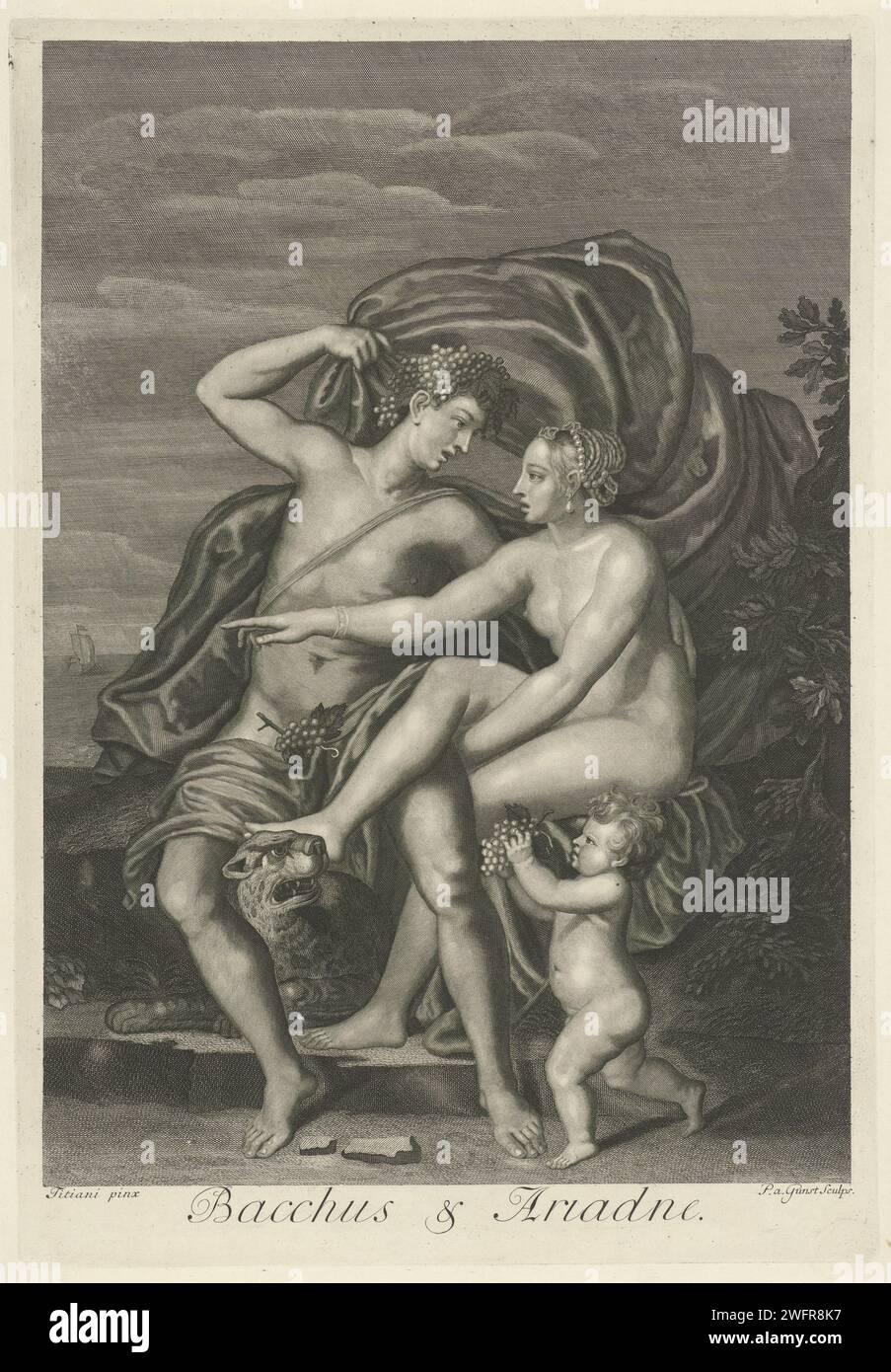 Bacchus and Ariadne, Pieter van Gunst, After Titian, 1659 - 1731 print Bacchus Troost Ariadne, who has been abandoned by theseus. A leopard under his feet. In the foreground a partying putto with a grape voucher. In the background a road -sailing boat (from Thoseus). Amsterdam paper engraving Bacchus Finds Ariadne on Naxos. Cupids: 'Amores', 'Amoretti', 'Putti' Stock Photohttps://www.alamy.com/image-license-details/?v=1https://www.alamy.com/bacchus-and-ariadne-pieter-van-gunst-after-titian-1659-1731-print-bacchus-troost-ariadne-who-has-been-abandoned-by-theseus-a-leopard-under-his-feet-in-the-foreground-a-partying-putto-with-a-grape-voucher-in-the-background-a-road-sailing-boat-from-thoseus-amsterdam-paper-engraving-bacchus-finds-ariadne-on-naxos-cupids-amores-amoretti-putti-image594884059.html
Bacchus and Ariadne, Pieter van Gunst, After Titian, 1659 - 1731 print Bacchus Troost Ariadne, who has been abandoned by theseus. A leopard under his feet. In the foreground a partying putto with a grape voucher. In the background a road -sailing boat (from Thoseus). Amsterdam paper engraving Bacchus Finds Ariadne on Naxos. Cupids: 'Amores', 'Amoretti', 'Putti' Stock Photohttps://www.alamy.com/image-license-details/?v=1https://www.alamy.com/bacchus-and-ariadne-pieter-van-gunst-after-titian-1659-1731-print-bacchus-troost-ariadne-who-has-been-abandoned-by-theseus-a-leopard-under-his-feet-in-the-foreground-a-partying-putto-with-a-grape-voucher-in-the-background-a-road-sailing-boat-from-thoseus-amsterdam-paper-engraving-bacchus-finds-ariadne-on-naxos-cupids-amores-amoretti-putti-image594884059.htmlRM2WFR8K7–Bacchus and Ariadne, Pieter van Gunst, After Titian, 1659 - 1731 print Bacchus Troost Ariadne, who has been abandoned by theseus. A leopard under his feet. In the foreground a partying putto with a grape voucher. In the background a road -sailing boat (from Thoseus). Amsterdam paper engraving Bacchus Finds Ariadne on Naxos. Cupids: 'Amores', 'Amoretti', 'Putti'
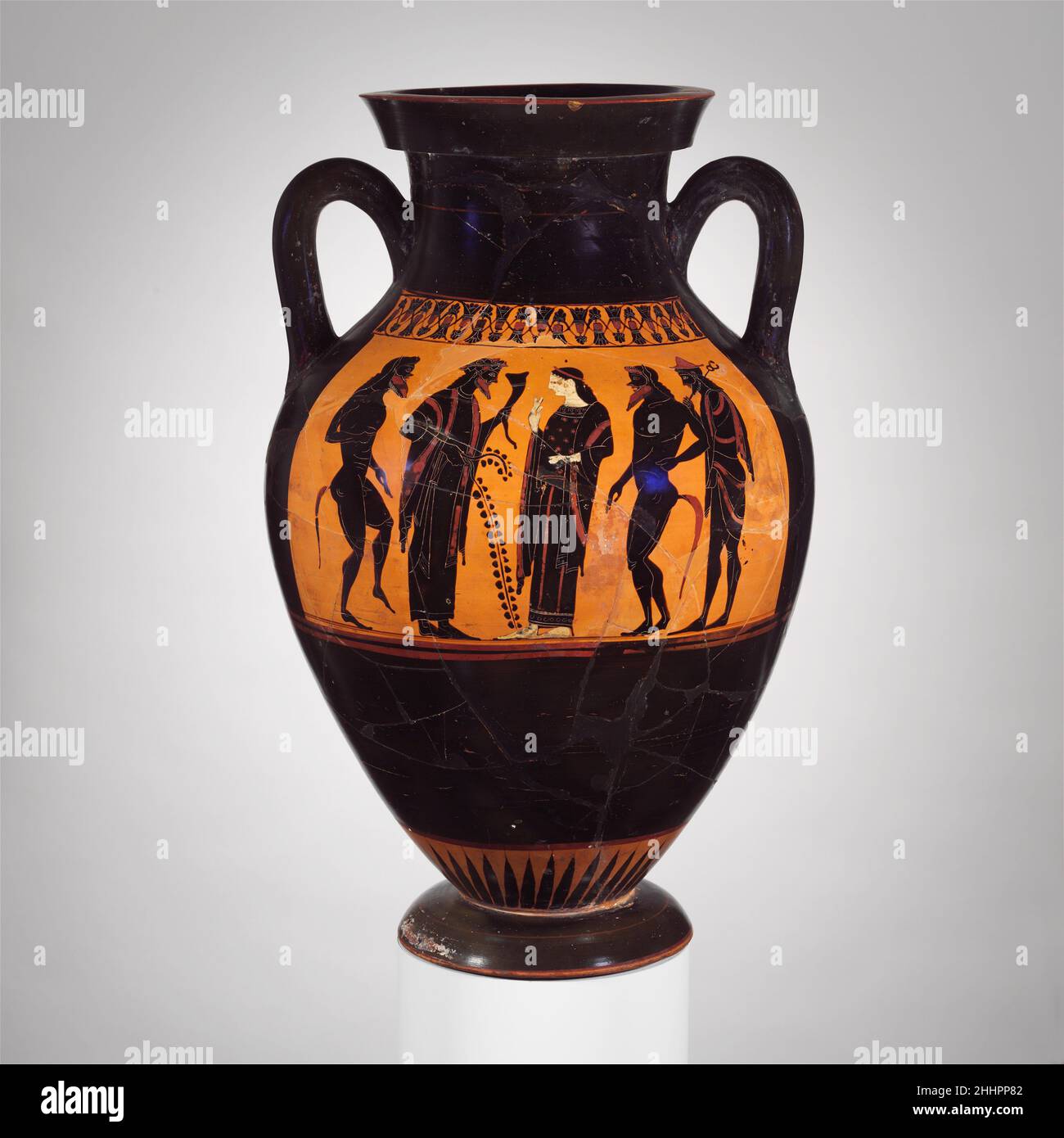 Terracotta amphora (jar) ca. 530–520 B.C. Attributed to the Bateman Group Obverse, Athena and Herakles in a chariotReverse, Dionysos and Ariadne with satyrs and HermesThere appears to be a chiastic relationship between the subjects on this vase. The goddess Athena is escorting Herakles to Mount Olympos on one side. On the other, Ariadne, who was rescued by Dionysos after having been abandoned on the island of Naxos by Theseus, is being led off by her new suitor, his entourage, and Hermes.. Terracotta amphora (jar) 248662 Stock Photohttps://www.alamy.com/image-license-details/?v=1https://www.alamy.com/terracotta-amphora-jar-ca-530520-bc-attributed-to-the-bateman-group-obverse-athena-and-herakles-in-a-chariotreverse-dionysos-and-ariadne-with-satyrs-and-hermesthere-appears-to-be-a-chiastic-relationship-between-the-subjects-on-this-vase-the-goddess-athena-is-escorting-herakles-to-mount-olympos-on-one-side-on-the-other-ariadne-who-was-rescued-by-dionysos-after-having-been-abandoned-on-the-island-of-naxos-by-theseus-is-being-led-off-by-her-new-suitor-his-entourage-and-hermes-terracotta-amphora-jar-248662-image458419138.html
Terracotta amphora (jar) ca. 530–520 B.C. Attributed to the Bateman Group Obverse, Athena and Herakles in a chariotReverse, Dionysos and Ariadne with satyrs and HermesThere appears to be a chiastic relationship between the subjects on this vase. The goddess Athena is escorting Herakles to Mount Olympos on one side. On the other, Ariadne, who was rescued by Dionysos after having been abandoned on the island of Naxos by Theseus, is being led off by her new suitor, his entourage, and Hermes.. Terracotta amphora (jar) 248662 Stock Photohttps://www.alamy.com/image-license-details/?v=1https://www.alamy.com/terracotta-amphora-jar-ca-530520-bc-attributed-to-the-bateman-group-obverse-athena-and-herakles-in-a-chariotreverse-dionysos-and-ariadne-with-satyrs-and-hermesthere-appears-to-be-a-chiastic-relationship-between-the-subjects-on-this-vase-the-goddess-athena-is-escorting-herakles-to-mount-olympos-on-one-side-on-the-other-ariadne-who-was-rescued-by-dionysos-after-having-been-abandoned-on-the-island-of-naxos-by-theseus-is-being-led-off-by-her-new-suitor-his-entourage-and-hermes-terracotta-amphora-jar-248662-image458419138.htmlRM2HHPP82–Terracotta amphora (jar) ca. 530–520 B.C. Attributed to the Bateman Group Obverse, Athena and Herakles in a chariotReverse, Dionysos and Ariadne with satyrs and HermesThere appears to be a chiastic relationship between the subjects on this vase. The goddess Athena is escorting Herakles to Mount Olympos on one side. On the other, Ariadne, who was rescued by Dionysos after having been abandoned on the island of Naxos by Theseus, is being led off by her new suitor, his entourage, and Hermes.. Terracotta amphora (jar) 248662
RM2HH3PPC–Terracotta bell-krater (mixing bowl) ca. 380–360 B.C. Connected in style with the Painter of the Long Overfalls Obverse, satyr and maenad. Reverse, two youthsThe representation is interesting because the maenad, asleep in an outdoor setting, recalls the pose of Ariadne when she was found on the island of Naxos by the wine god Dionysos; she had been abandoned there by Theseus. The iconography of an 'elevated' mythological subject has been applied to members of Dionysos' retinue.. Terracotta bell-krater (mixing bowl). Greek, South Italian, Apulian. ca. 380–360 B.C.. Terracotta; red-figure. Late
 Terracotta bell-krater (bowl for mixing wine and water), late 5th century B.C.–early 4th century B.C Stock Photohttps://www.alamy.com/image-license-details/?v=1https://www.alamy.com/stock-image-terracotta-bell-krater-bowl-for-mixing-wine-and-water-late-5th-century-162427141.html
Terracotta bell-krater (bowl for mixing wine and water), late 5th century B.C.–early 4th century B.C Stock Photohttps://www.alamy.com/image-license-details/?v=1https://www.alamy.com/stock-image-terracotta-bell-krater-bowl-for-mixing-wine-and-water-late-5th-century-162427141.htmlRMKC75D9–Terracotta bell-krater (bowl for mixing wine and water), late 5th century B.C.–early 4th century B.C
 Bacchus and Ariadne 1720s Giovanni Antonio Pellegrini Italian When Bacchus arrived on the island of Naxos, he found the beautiful daughter of Minos, Ariadne, who had been abandoned by Theseus. Bacchus married her and her crown was transformed into a constellation by Jupiter. In the present picture Bacchus, wearing vine leaves in his hair, places a ring on Ariadne's finger. The subject was treated by Pellegrini a number of times. The present picture may date from after 1721, following Pellegrini's return to Venice and his extensive work in England, Düsseldorf, the Low Countries, and Paris.. Bac Stock Photohttps://www.alamy.com/image-license-details/?v=1https://www.alamy.com/bacchus-and-ariadne-1720s-giovanni-antonio-pellegrini-italian-when-bacchus-arrived-on-the-island-of-naxos-he-found-the-beautiful-daughter-of-minos-ariadne-who-had-been-abandoned-by-theseus-bacchus-married-her-and-her-crown-was-transformed-into-a-constellation-by-jupiter-in-the-present-picture-bacchus-wearing-vine-leaves-in-his-hair-places-a-ring-on-ariadnes-finger-the-subject-was-treated-by-pellegrini-a-number-of-times-the-present-picture-may-date-from-after-1721-following-pellegrinis-return-to-venice-and-his-extensive-work-in-england-dsseldorf-the-low-countries-and-paris-bac-image457776713.html
Bacchus and Ariadne 1720s Giovanni Antonio Pellegrini Italian When Bacchus arrived on the island of Naxos, he found the beautiful daughter of Minos, Ariadne, who had been abandoned by Theseus. Bacchus married her and her crown was transformed into a constellation by Jupiter. In the present picture Bacchus, wearing vine leaves in his hair, places a ring on Ariadne's finger. The subject was treated by Pellegrini a number of times. The present picture may date from after 1721, following Pellegrini's return to Venice and his extensive work in England, Düsseldorf, the Low Countries, and Paris.. Bac Stock Photohttps://www.alamy.com/image-license-details/?v=1https://www.alamy.com/bacchus-and-ariadne-1720s-giovanni-antonio-pellegrini-italian-when-bacchus-arrived-on-the-island-of-naxos-he-found-the-beautiful-daughter-of-minos-ariadne-who-had-been-abandoned-by-theseus-bacchus-married-her-and-her-crown-was-transformed-into-a-constellation-by-jupiter-in-the-present-picture-bacchus-wearing-vine-leaves-in-his-hair-places-a-ring-on-ariadnes-finger-the-subject-was-treated-by-pellegrini-a-number-of-times-the-present-picture-may-date-from-after-1721-following-pellegrinis-return-to-venice-and-his-extensive-work-in-england-dsseldorf-the-low-countries-and-paris-bac-image457776713.htmlRM2HGNET9–Bacchus and Ariadne 1720s Giovanni Antonio Pellegrini Italian When Bacchus arrived on the island of Naxos, he found the beautiful daughter of Minos, Ariadne, who had been abandoned by Theseus. Bacchus married her and her crown was transformed into a constellation by Jupiter. In the present picture Bacchus, wearing vine leaves in his hair, places a ring on Ariadne's finger. The subject was treated by Pellegrini a number of times. The present picture may date from after 1721, following Pellegrini's return to Venice and his extensive work in England, Düsseldorf, the Low Countries, and Paris.. Bac
 Ariadne ca. 1831–35 Asher Brown Durand American Before he became a painter, Durand was considered the foremost engraver in the United States. His usual procedure was to start by making a copy in oils of the work to be engraved that was equal in size to the intended print. 'Ariadne' is one such copy, made after a large history painting by John Vanderlyn (Pennsylvania Academy of the Fine Arts, Philadelphia). Ariadne was a Cretan princess briefly loved by Theseus. He abandoned her, however, on the island of Naxos, and she is shown here in her desolation. Durand’s copy modified Vanderlyn’s crisp N Stock Photohttps://www.alamy.com/image-license-details/?v=1https://www.alamy.com/ariadne-ca-183135-asher-brown-durand-american-before-he-became-a-painter-durand-was-considered-the-foremost-engraver-in-the-united-states-his-usual-procedure-was-to-start-by-making-a-copy-in-oils-of-the-work-to-be-engraved-that-was-equal-in-size-to-the-intended-print-ariadne-is-one-such-copy-made-after-a-large-history-painting-by-john-vanderlyn-pennsylvania-academy-of-the-fine-arts-philadelphia-ariadne-was-a-cretan-princess-briefly-loved-by-theseus-he-abandoned-her-however-on-the-island-of-naxos-and-she-is-shown-here-in-her-desolation-durands-copy-modified-vanderlyns-crisp-n-image458066131.html
Ariadne ca. 1831–35 Asher Brown Durand American Before he became a painter, Durand was considered the foremost engraver in the United States. His usual procedure was to start by making a copy in oils of the work to be engraved that was equal in size to the intended print. 'Ariadne' is one such copy, made after a large history painting by John Vanderlyn (Pennsylvania Academy of the Fine Arts, Philadelphia). Ariadne was a Cretan princess briefly loved by Theseus. He abandoned her, however, on the island of Naxos, and she is shown here in her desolation. Durand’s copy modified Vanderlyn’s crisp N Stock Photohttps://www.alamy.com/image-license-details/?v=1https://www.alamy.com/ariadne-ca-183135-asher-brown-durand-american-before-he-became-a-painter-durand-was-considered-the-foremost-engraver-in-the-united-states-his-usual-procedure-was-to-start-by-making-a-copy-in-oils-of-the-work-to-be-engraved-that-was-equal-in-size-to-the-intended-print-ariadne-is-one-such-copy-made-after-a-large-history-painting-by-john-vanderlyn-pennsylvania-academy-of-the-fine-arts-philadelphia-ariadne-was-a-cretan-princess-briefly-loved-by-theseus-he-abandoned-her-however-on-the-island-of-naxos-and-she-is-shown-here-in-her-desolation-durands-copy-modified-vanderlyns-crisp-n-image458066131.htmlRM2HH6M0K–Ariadne ca. 1831–35 Asher Brown Durand American Before he became a painter, Durand was considered the foremost engraver in the United States. His usual procedure was to start by making a copy in oils of the work to be engraved that was equal in size to the intended print. 'Ariadne' is one such copy, made after a large history painting by John Vanderlyn (Pennsylvania Academy of the Fine Arts, Philadelphia). Ariadne was a Cretan princess briefly loved by Theseus. He abandoned her, however, on the island of Naxos, and she is shown here in her desolation. Durand’s copy modified Vanderlyn’s crisp N
 Terracotta bell-krater (bowl for mixing wine and water). Culture: Greek, Attic. Dimensions: Height: 13 3/4in. (34.9cm), Diam.: 14 3/8 in. (36.5 cm). Date: late 5th century B.C.-early 4th century B.C.. Obverse, Ariadne and two satyrs Reverse, three youths Ariadne is often recognizable through her recumbent position. She was asleep when Theseus abandoned her on the island of Naxos. And she is often depicted as reclining with Dionysos. The presence of two satyrs indicates her identity here. She reclines under a vine arbor, another reminder of Dionysos. It is interesting that one of the satyrs Stock Photohttps://www.alamy.com/image-license-details/?v=1https://www.alamy.com/terracotta-bell-krater-bowl-for-mixing-wine-and-water-culture-greek-attic-dimensions-height-13-34in-349cm-diam-14-38-in-365-cm-date-late-5th-century-bc-early-4th-century-bc-obverse-ariadne-and-two-satyrs-reverse-three-youths-ariadne-is-often-recognizable-through-her-recumbent-position-she-was-asleep-when-theseus-abandoned-her-on-the-island-of-naxos-and-she-is-often-depicted-as-reclining-with-dionysos-the-presence-of-two-satyrs-indicates-her-identity-here-she-reclines-under-a-vine-arbor-another-reminder-of-dionysos-it-is-interesting-that-one-of-the-satyrs-image212901497.html
Terracotta bell-krater (bowl for mixing wine and water). Culture: Greek, Attic. Dimensions: Height: 13 3/4in. (34.9cm), Diam.: 14 3/8 in. (36.5 cm). Date: late 5th century B.C.-early 4th century B.C.. Obverse, Ariadne and two satyrs Reverse, three youths Ariadne is often recognizable through her recumbent position. She was asleep when Theseus abandoned her on the island of Naxos. And she is often depicted as reclining with Dionysos. The presence of two satyrs indicates her identity here. She reclines under a vine arbor, another reminder of Dionysos. It is interesting that one of the satyrs Stock Photohttps://www.alamy.com/image-license-details/?v=1https://www.alamy.com/terracotta-bell-krater-bowl-for-mixing-wine-and-water-culture-greek-attic-dimensions-height-13-34in-349cm-diam-14-38-in-365-cm-date-late-5th-century-bc-early-4th-century-bc-obverse-ariadne-and-two-satyrs-reverse-three-youths-ariadne-is-often-recognizable-through-her-recumbent-position-she-was-asleep-when-theseus-abandoned-her-on-the-island-of-naxos-and-she-is-often-depicted-as-reclining-with-dionysos-the-presence-of-two-satyrs-indicates-her-identity-here-she-reclines-under-a-vine-arbor-another-reminder-of-dionysos-it-is-interesting-that-one-of-the-satyrs-image212901497.htmlRMPAAE0W–Terracotta bell-krater (bowl for mixing wine and water). Culture: Greek, Attic. Dimensions: Height: 13 3/4in. (34.9cm), Diam.: 14 3/8 in. (36.5 cm). Date: late 5th century B.C.-early 4th century B.C.. Obverse, Ariadne and two satyrs Reverse, three youths Ariadne is often recognizable through her recumbent position. She was asleep when Theseus abandoned her on the island of Naxos. And she is often depicted as reclining with Dionysos. The presence of two satyrs indicates her identity here. She reclines under a vine arbor, another reminder of Dionysos. It is interesting that one of the satyrs
 Terracotta bell-krater (bowl for mixing wine and water) late 5th century B.C.–early 4th century B.C. Greek, Attic Obverse, Ariadne and two satyrsReverse, three youthsAriadne is often recognizable through her recumbent position. She was asleep when Theseus abandoned her on the island of Naxos. And she is often depicted as reclining with Dionysos. The presence of two satyrs indicates her identity here. She reclines under a vine arbor, another reminder of Dionysos. It is interesting that one of the satyrs carries a torch, suggesting a night scene. The other holds a lyre, which may refer to the th Stock Photohttps://www.alamy.com/image-license-details/?v=1https://www.alamy.com/terracotta-bell-krater-bowl-for-mixing-wine-and-water-late-5th-century-bcearly-4th-century-bc-greek-attic-obverse-ariadne-and-two-satyrsreverse-three-youthsariadne-is-often-recognizable-through-her-recumbent-position-she-was-asleep-when-theseus-abandoned-her-on-the-island-of-naxos-and-she-is-often-depicted-as-reclining-with-dionysos-the-presence-of-two-satyrs-indicates-her-identity-here-she-reclines-under-a-vine-arbor-another-reminder-of-dionysos-it-is-interesting-that-one-of-the-satyrs-carries-a-torch-suggesting-a-night-scene-the-other-holds-a-lyre-which-may-refer-to-the-th-image458463633.html
Terracotta bell-krater (bowl for mixing wine and water) late 5th century B.C.–early 4th century B.C. Greek, Attic Obverse, Ariadne and two satyrsReverse, three youthsAriadne is often recognizable through her recumbent position. She was asleep when Theseus abandoned her on the island of Naxos. And she is often depicted as reclining with Dionysos. The presence of two satyrs indicates her identity here. She reclines under a vine arbor, another reminder of Dionysos. It is interesting that one of the satyrs carries a torch, suggesting a night scene. The other holds a lyre, which may refer to the th Stock Photohttps://www.alamy.com/image-license-details/?v=1https://www.alamy.com/terracotta-bell-krater-bowl-for-mixing-wine-and-water-late-5th-century-bcearly-4th-century-bc-greek-attic-obverse-ariadne-and-two-satyrsreverse-three-youthsariadne-is-often-recognizable-through-her-recumbent-position-she-was-asleep-when-theseus-abandoned-her-on-the-island-of-naxos-and-she-is-often-depicted-as-reclining-with-dionysos-the-presence-of-two-satyrs-indicates-her-identity-here-she-reclines-under-a-vine-arbor-another-reminder-of-dionysos-it-is-interesting-that-one-of-the-satyrs-carries-a-torch-suggesting-a-night-scene-the-other-holds-a-lyre-which-may-refer-to-the-th-image458463633.htmlRM2HHTR15–Terracotta bell-krater (bowl for mixing wine and water) late 5th century B.C.–early 4th century B.C. Greek, Attic Obverse, Ariadne and two satyrsReverse, three youthsAriadne is often recognizable through her recumbent position. She was asleep when Theseus abandoned her on the island of Naxos. And she is often depicted as reclining with Dionysos. The presence of two satyrs indicates her identity here. She reclines under a vine arbor, another reminder of Dionysos. It is interesting that one of the satyrs carries a torch, suggesting a night scene. The other holds a lyre, which may refer to the th
 Ariadne Abandoned by Theseus before 1782 by Angelica Kauffmann Stock Photohttps://www.alamy.com/image-license-details/?v=1https://www.alamy.com/ariadne-abandoned-by-theseus-before-1782-by-angelica-kauffmann-image559642625.html
Ariadne Abandoned by Theseus before 1782 by Angelica Kauffmann Stock Photohttps://www.alamy.com/image-license-details/?v=1https://www.alamy.com/ariadne-abandoned-by-theseus-before-1782-by-angelica-kauffmann-image559642625.htmlRM2REDWTH–Ariadne Abandoned by Theseus before 1782 by Angelica Kauffmann
 Bacchus and Ariadne; Mythological love stories. Bacchus Troost Ariadne, who has been abandoned by Theseus. Under his feet a leopard. In the foreground a partying putto with a grape food. In the background a displacing boat (from Theseus). Stock Photohttps://www.alamy.com/image-license-details/?v=1https://www.alamy.com/bacchus-and-ariadne-mythological-love-stories-bacchus-troost-ariadne-who-has-been-abandoned-by-theseus-under-his-feet-a-leopard-in-the-foreground-a-partying-putto-with-a-grape-food-in-the-background-a-displacing-boat-from-theseus-image431650262.html
Bacchus and Ariadne; Mythological love stories. Bacchus Troost Ariadne, who has been abandoned by Theseus. Under his feet a leopard. In the foreground a partying putto with a grape food. In the background a displacing boat (from Theseus). Stock Photohttps://www.alamy.com/image-license-details/?v=1https://www.alamy.com/bacchus-and-ariadne-mythological-love-stories-bacchus-troost-ariadne-who-has-been-abandoned-by-theseus-under-his-feet-a-leopard-in-the-foreground-a-partying-putto-with-a-grape-food-in-the-background-a-displacing-boat-from-theseus-image431650262.htmlRM2G27A8P–Bacchus and Ariadne; Mythological love stories. Bacchus Troost Ariadne, who has been abandoned by Theseus. Under his feet a leopard. In the foreground a partying putto with a grape food. In the background a displacing boat (from Theseus).
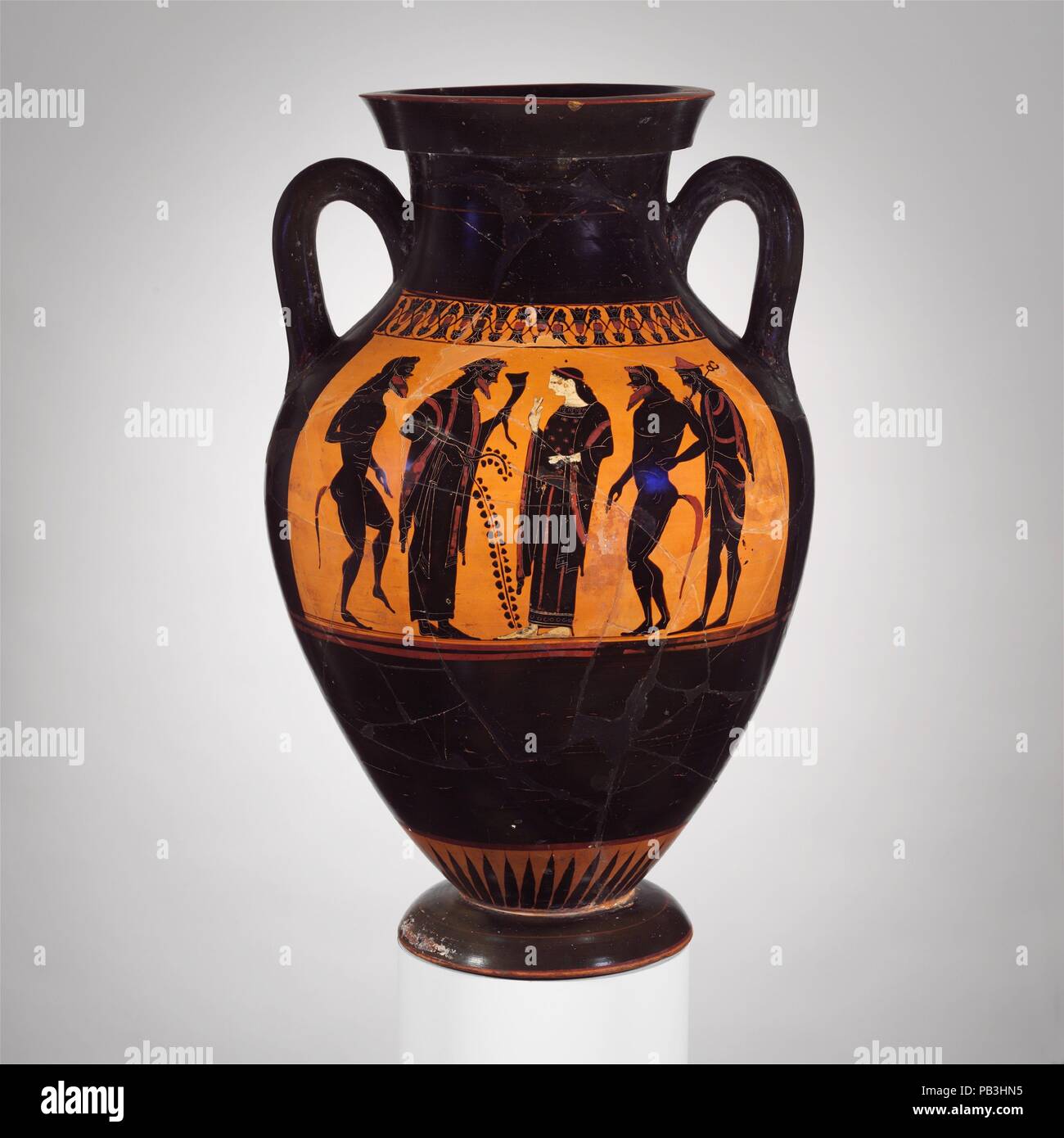 Terracotta amphora (jar). Culture: Greek, Attic. Dimensions: H. 21 13/16 in. (55.4 cm) diameter 14 in. (35.6 cm). Date: ca. 530-520 B.C.. Obverse, Athena and Herakles in a chariot Reverse, Dionysos and Ariadne with satyrs and Hermes There appears to be a chiastic relationship between the subjects on this vase. The goddess Athena is escorting Herakles to Mount Olympos on one side. On the other, Ariadne, who was rescued by Dionysos after having been abandoned on the island of Naxos by Theseus, is being led off by her new suitor, his entourage, and Hermes. Museum: Metropolitan Museum of Art, Stock Photohttps://www.alamy.com/image-license-details/?v=1https://www.alamy.com/terracotta-amphora-jar-culture-greek-attic-dimensions-h-21-1316-in-554-cm-diameter-14-in-356-cm-date-ca-530-520-bc-obverse-athena-and-herakles-in-a-chariot-reverse-dionysos-and-ariadne-with-satyrs-and-hermes-there-appears-to-be-a-chiastic-relationship-between-the-subjects-on-this-vase-the-goddess-athena-is-escorting-herakles-to-mount-olympos-on-one-side-on-the-other-ariadne-who-was-rescued-by-dionysos-after-having-been-abandoned-on-the-island-of-naxos-by-theseus-is-being-led-off-by-her-new-suitor-his-entourage-and-hermes-museum-metropolitan-museum-of-art-image213365409.html
Terracotta amphora (jar). Culture: Greek, Attic. Dimensions: H. 21 13/16 in. (55.4 cm) diameter 14 in. (35.6 cm). Date: ca. 530-520 B.C.. Obverse, Athena and Herakles in a chariot Reverse, Dionysos and Ariadne with satyrs and Hermes There appears to be a chiastic relationship between the subjects on this vase. The goddess Athena is escorting Herakles to Mount Olympos on one side. On the other, Ariadne, who was rescued by Dionysos after having been abandoned on the island of Naxos by Theseus, is being led off by her new suitor, his entourage, and Hermes. Museum: Metropolitan Museum of Art, Stock Photohttps://www.alamy.com/image-license-details/?v=1https://www.alamy.com/terracotta-amphora-jar-culture-greek-attic-dimensions-h-21-1316-in-554-cm-diameter-14-in-356-cm-date-ca-530-520-bc-obverse-athena-and-herakles-in-a-chariot-reverse-dionysos-and-ariadne-with-satyrs-and-hermes-there-appears-to-be-a-chiastic-relationship-between-the-subjects-on-this-vase-the-goddess-athena-is-escorting-herakles-to-mount-olympos-on-one-side-on-the-other-ariadne-who-was-rescued-by-dionysos-after-having-been-abandoned-on-the-island-of-naxos-by-theseus-is-being-led-off-by-her-new-suitor-his-entourage-and-hermes-museum-metropolitan-museum-of-art-image213365409.htmlRMPB3HN5–Terracotta amphora (jar). Culture: Greek, Attic. Dimensions: H. 21 13/16 in. (55.4 cm) diameter 14 in. (35.6 cm). Date: ca. 530-520 B.C.. Obverse, Athena and Herakles in a chariot Reverse, Dionysos and Ariadne with satyrs and Hermes There appears to be a chiastic relationship between the subjects on this vase. The goddess Athena is escorting Herakles to Mount Olympos on one side. On the other, Ariadne, who was rescued by Dionysos after having been abandoned on the island of Naxos by Theseus, is being led off by her new suitor, his entourage, and Hermes. Museum: Metropolitan Museum of Art,
 Ariadne Abandoned by Theseus 1774 by Angelica Kauffmann Stock Photohttps://www.alamy.com/image-license-details/?v=1https://www.alamy.com/ariadne-abandoned-by-theseus-1774-by-angelica-kauffmann-image543875856.html
Ariadne Abandoned by Theseus 1774 by Angelica Kauffmann Stock Photohttps://www.alamy.com/image-license-details/?v=1https://www.alamy.com/ariadne-abandoned-by-theseus-1774-by-angelica-kauffmann-image543875856.htmlRM2PGRK5M–Ariadne Abandoned by Theseus 1774 by Angelica Kauffmann
 Bacchus and Ariadne. Ariadne, the daughter of King Minos of Crete, complained to Bacchus, the god of wine, that she had been abandoned on the island of Naxos by her lover Theseus. Bacchus is here holding Ariadne’s diadem. He will cast it up into the sky, where it will turn into a constellation. Stock Photohttps://www.alamy.com/image-license-details/?v=1https://www.alamy.com/bacchus-and-ariadne-ariadne-the-daughter-of-king-minos-of-crete-complained-to-bacchus-the-god-of-wine-that-she-had-been-abandoned-on-the-island-of-naxos-by-her-lover-theseus-bacchus-is-here-holding-ariadnes-diadem-he-will-cast-it-up-into-the-sky-where-it-will-turn-into-a-constellation-image431591794.html
Bacchus and Ariadne. Ariadne, the daughter of King Minos of Crete, complained to Bacchus, the god of wine, that she had been abandoned on the island of Naxos by her lover Theseus. Bacchus is here holding Ariadne’s diadem. He will cast it up into the sky, where it will turn into a constellation. Stock Photohttps://www.alamy.com/image-license-details/?v=1https://www.alamy.com/bacchus-and-ariadne-ariadne-the-daughter-of-king-minos-of-crete-complained-to-bacchus-the-god-of-wine-that-she-had-been-abandoned-on-the-island-of-naxos-by-her-lover-theseus-bacchus-is-here-holding-ariadnes-diadem-he-will-cast-it-up-into-the-sky-where-it-will-turn-into-a-constellation-image431591794.htmlRM2G24KMJ–Bacchus and Ariadne. Ariadne, the daughter of King Minos of Crete, complained to Bacchus, the god of wine, that she had been abandoned on the island of Naxos by her lover Theseus. Bacchus is here holding Ariadne’s diadem. He will cast it up into the sky, where it will turn into a constellation.
 Roman fresco depicting Ariadne forsaken by Theseus whose ship can be seen on the horizon. Second half of 2nd century. From Pompeii. National Archaeological Museum. Naples. Italy. Stock Photohttps://www.alamy.com/image-license-details/?v=1https://www.alamy.com/roman-fresco-depicting-ariadne-forsaken-by-theseus-whose-ship-can-be-seen-on-the-horizon-second-half-of-2nd-century-from-pompeii-national-archaeological-museum-naples-italy-image211455414.html
Roman fresco depicting Ariadne forsaken by Theseus whose ship can be seen on the horizon. Second half of 2nd century. From Pompeii. National Archaeological Museum. Naples. Italy. Stock Photohttps://www.alamy.com/image-license-details/?v=1https://www.alamy.com/roman-fresco-depicting-ariadne-forsaken-by-theseus-whose-ship-can-be-seen-on-the-horizon-second-half-of-2nd-century-from-pompeii-national-archaeological-museum-naples-italy-image211455414.htmlRMP80HF2–Roman fresco depicting Ariadne forsaken by Theseus whose ship can be seen on the horizon. Second half of 2nd century. From Pompeii. National Archaeological Museum. Naples. Italy.